Introduction to Refraction of Light
Free download of step by step solutions for Class 10 Physics chapter 4 - Refraction of Light at Plane Surfaces of ICSE Board.
Free download of step by step solutions for Class 10 Physics chapter 4 - Refraction of Light at Plane Surfaces of ICSE Board (Concise - Selina Publishers). All exercise questions are solved & explained by an expert teacher and as per ICSE board guidelines.
Access ICSE Selina Solutions for 10 Physics Chapter 4 - Refraction of Light at Plane Surface
Exercise-4(A)
1. What do you understand by refraction of light?
Ans: The change in the direction of the path of light, when it passes from one medium to another medium, is known as refraction of light.
2. Draw diagrams to show the refraction of light from (i) air to glass, (ii) glass to air. In each diagram, label the incident ray, refracted ray, the angle of incidence (i) and the angle of refraction (r).
Ans: Diagram shows below is refraction of light, travel from Air to glass
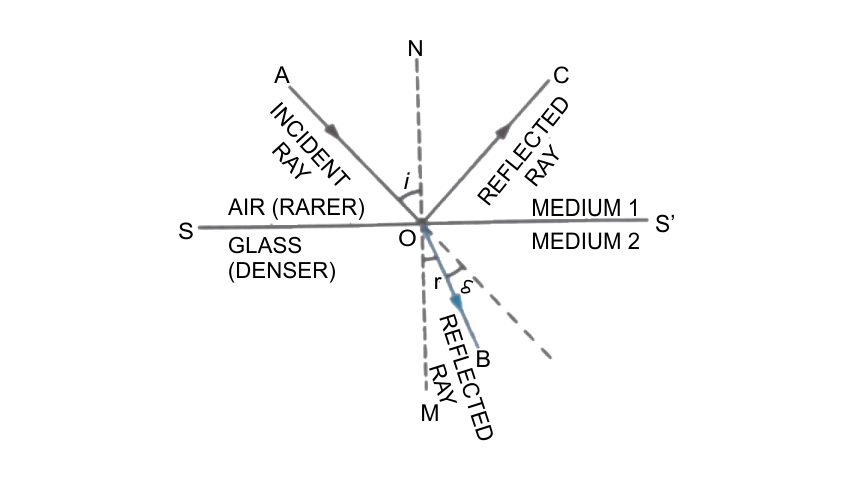
Diagram shows below is refraction of light, travel from Glass to Air
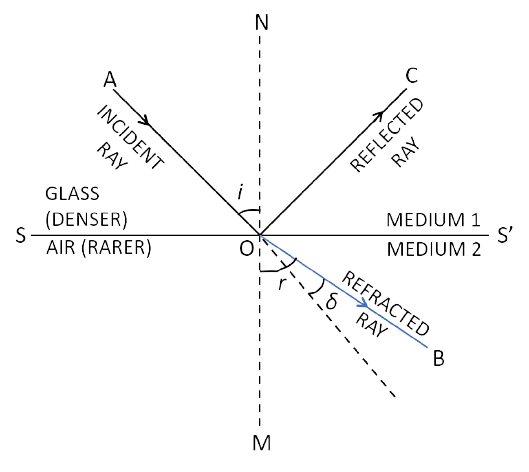
3. A ray of light is incident normally on a plane glass slab. What will be the angle of refraction and the angle of deviation for the ray?
Ans: If the ray of light which is incident normally on a plane glass slab then it passes un deviated means a ray suffers no bending at the surface because the angle of incidence is 0o So, if angle of incidence, i=0o then the angle of refraction also r=0o and the angle of deviation of the ray will also 0o.
4. An obliquely incident light ray bends at the surface due to change in speed, when passing from one medium to other. The ray does not bend when it is incident normally. Will the ray have a different speed in the other medium?
Ans: True because when the medium changes, the speed of light will change.
5. What is the cause of refraction of light when it passes from one medium to another?
Ans: The refraction of light (or change in the direction of path of light in another medium) occurs because light travels with different speeds in different mediums. When a ray of light travels from one medium to another medium, its direction (except for i=0o.) changes because of change in speed.
6. A light ray suffers reflection and refraction at the boundary in passing from air to water. Draw a neat labelled diagram to show it.
Ans: Air is a rarer medium and water is denser than air with a refractive index of 1.33. So when a light ray travels from air to water it will bend towards the normal.
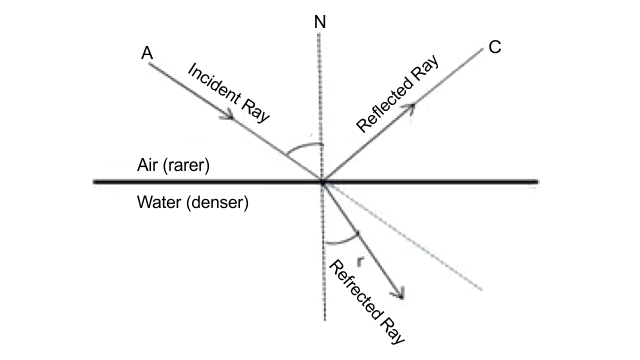
7. A ray of light passes from medium 1 to medium 2. Which of the following quantities of the refracted ray will differ from that of the incident ray: speed, intensity, frequency, wave length?
Ans: Its speed, wavelength, and intensity.
8. State the Snell's laws of refraction of light.
Ans: The Snell's laws of refraction is:
1. The incident ray, the refracted ray and the normal at the point of incidence, lie in the same plane.
2. The ratio of the sine of the angle of incidence to the sine of the angle of refraction is constant for the pair of the given media.
Sin i/Sin r = 1 μ 2
Where 1 μ 2 is known as the refractive index of the medium second with respect to the medium first.
9. Define the term refractive index of a medium. Can it be less than 1?
Ans: The refractive index of the second medium with respect to the first medium is defined as the ratio of the sine of angle of incidence in the first medium to the sine of the angle of refraction in the second medium. Refractive index of a medium is always greater than 1 because the speed of light in any medium is always less than vacuum.
10. (a) Compare the speeds of light of wavelength 4000 Ao (i.e. violet light) and 8000 Ao (i.e. red light) in vacuum.
Ans: (a) Speed of light depends on medium not on wavelength hence speed will be same for both.
(b) How is the refractive index of a medium related to the speed of light in it and in vacuum or air?
Ans: Refractive index of a denser medium is high and therefore the speed of light in such a medium is lower in comparison to the speed of light in a medium which has a lower refractive index.
11. A light ray passes from water to (i) air, and (ii) glass. In each case, state how the speed of light changes.
Ans: Refractive index of water, μ w = 1.33
Refractive index of air, μ a = 1.0003
Refractive index of glass, μ g = 1.5
This implies that μ a < μ w< μ g
The speed of light decreases when it travels from a rarer medium to denser medium and increases when it travels from a denser medium to rarer medium. So, the speed of light increases when light rays travel from water to air and the speed of light decreases when light rays travel from water to glass.
12. A light ray in passing from water to a medium (a) speeds up (b) slows down. In each case,
(i) Give one example of the medium,
Ans: When speed increases it means that the refractive index of the medium is lesser than water.
(ii) State whether the refractive index of medium is equal to, less than or greater than the refractive index of water.
Ans: When the speed decreases it means that the refractive index of the medium is greater than water.
13. What do you understand by the statement 'the refractive index of the glass is 1.5 for white light'?
Ans: The refractive index of glass is 1.5 for white light means speed of white light in the air is 1.5 times greater than in the glass.
14. A monochromatic ray of light passes from air to glass. The wavelength of light in air is λ , the speed of light in air is c and in glass is v. If the refractive index of glass is 1.5, write down
(a) The relationship between c and v.
Ans: (a) The relation between speed of light in air (c) and in glass (v) is given by
𝜇 = c/v or c = 1.5 v
(b) The wavelength of light in glass.
Ans:The wavelength of light in glass (λ 1) is,
μ = 𝜆 /𝜆 1
= 𝜆 / 1.5
15. A boy uses the blue colour of the light to find the refractive index of glass. He then repeats the experiment using the red colour of light. Will the refractive index be the same or different in the two cases? Give reason to support your answer.
Ans: The refractive index is different. The speed of blue light in glass is lesser than red light and refractive index of glass is given as,
μ =c / speed of light in glass
so, μblue › μred
16. (a)For which colour of white light, is the refractive index of a transparent medium
(i) The least
Ans: least for the red colour and
(a) (ii) The most?
Ans: most for the violet colour.
(b) Which colour of light travels fastest in any medium except air?
Ans: Red colour travels the fastest because its wavelength is the highest.
17. Name two factors on which the refractive index of a medium depends? State how it depends on the factor stated by you.
Ans: The refractive index of a medium depends on two factors are:
1) Nature of the medium i.e. its optical density (e.g. μg=1.5, μw=1.33) - Smaller the speed of light in a medium relative to air then higher refractive index of that medium.
2) Physical conditions like temperature - on increasing temperature, the speed of light in medium increases, so that the refractive index of medium decreases.
18. How does the refractive index of a medium depend on the wavelength of light used?
Ans: Refractive index of the medium decreases with increase in wavelength of light ray. Refractive index of a medium for violet light (least wavelength) is greater than red light (greatest wavelength).
19. How does the refractive index of a medium depend on its temperature?
Ans: Refractive index of the medium decreases with increase in temperature. Increase in temperature, the speed of light in those mediums increases; So, the refractive index (= velocity of light in vacuum/velocity of light in medium) decreases.
20. Light of a single colour is passed through a liquid having a piece of glass suspended in it. On changing the temperature of liquid, at a particular temperature, the glass piece is not seen.
(a) When is the glass piece not seen?
Ans: The glass piece will not see if the refractive index of liquid becomes equal to the refractive index of glass.
(b) Why is the light of a single colour used?
Ans: Light of a single colour is used because the refractive index of a medium (glass or liquid) is different for the different colours of light.
21. In the figure below, a ray of light A incident from air suffers partial reflection and refraction at the boundary of water.
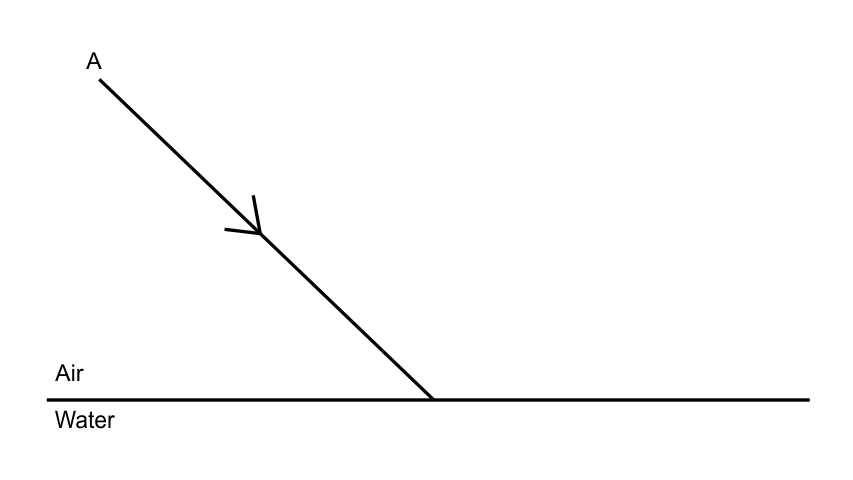
(a) Complete the diagram showing (i) the reflected ray B and (ii)the refracted ray C.
Ans:
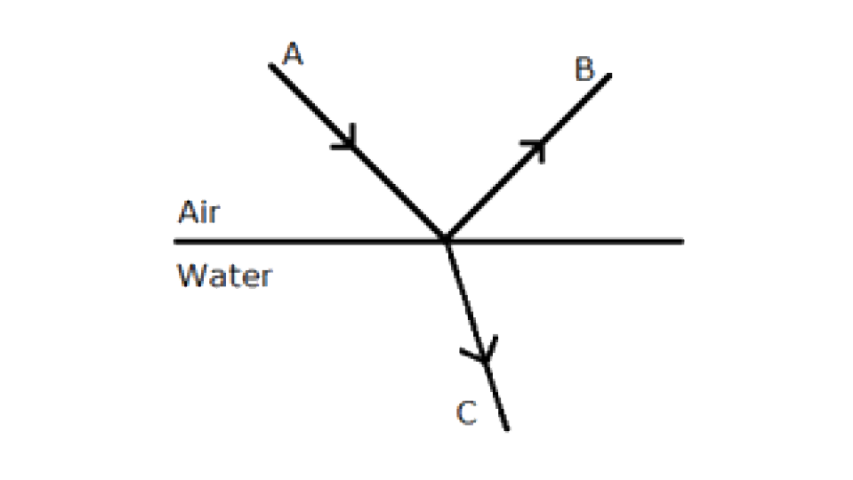
(b) How are the angles of incidence i and refraction r related?
Ans: The angles of incidence and angle of refraction are related to each other by Snell's law relation,is
sin i / sin r = μw
22. The diagram alongside shows the refraction of a ray of light from air to liquid.
(a) Write the values of (i) angle of incidence
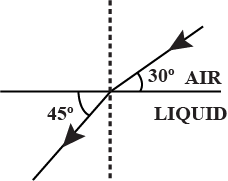
Ans: Angle of incidence is the angle between incident ray and normal of the surface.
\[\Rightarrow \text{ Wavelength}\text{ of}\text{ light}\text{ in}\text{glass}\text{ }=\text{ }2\text{ }/\text{ }3\text{ }\times \text{ }5400\text{ }\text{ }=\text{ }3600\text{ }\]
(a) Write the values of (ii) angle of refraction.
Ans: Angle of refraction is the angle between refracted ray and normal of the surface.
$\therefore \text{ }\angle r=90{}^\circ -40{}^\circ =45{}^\circ $
(b) Use Snell's law to find the refractive index of liquid with respect to air.
Ans: According to Snell's law.
air µ liquid = sin i / sin r = sin 60° / sin 45°
$=(\sqrt{3}\times \sqrt{2})/(2\times 1)$
$=\sqrt{(3/2)}$
Or = 1.2
23. The refractive index of water with respect to air is aμw and of glass with respect to air is aμg . Express the refractive index of glass with respect to water.
Ans: Refractive index of glass with respect to water is (wμg ),
wμg = aμg / aμw
24. What is lateral displacement? Draw a ray diagram showing the lateral displacement of a ray of light when it passes through a parallel sided glass slab.
Ans: Perpendicular distance between emergent ray and the direction of the incident ray is called the lateral displacement. In the figure below, XY is the perpendicular distance or the lateral displacement.
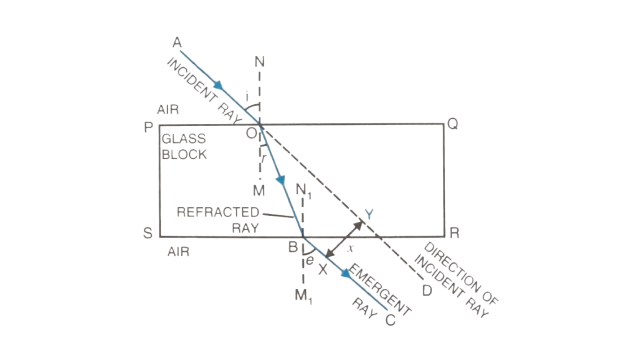
25. A ray of light strikes the surface at a rectangular glass slab such that the angle of incidence is (i) 0o, (ii) 45o. In each case, draw a diagram to show the path taken by the ray as it passes through the glass slab and emerges from it.
Ans: Case (i) When angle of incidence is 0o.
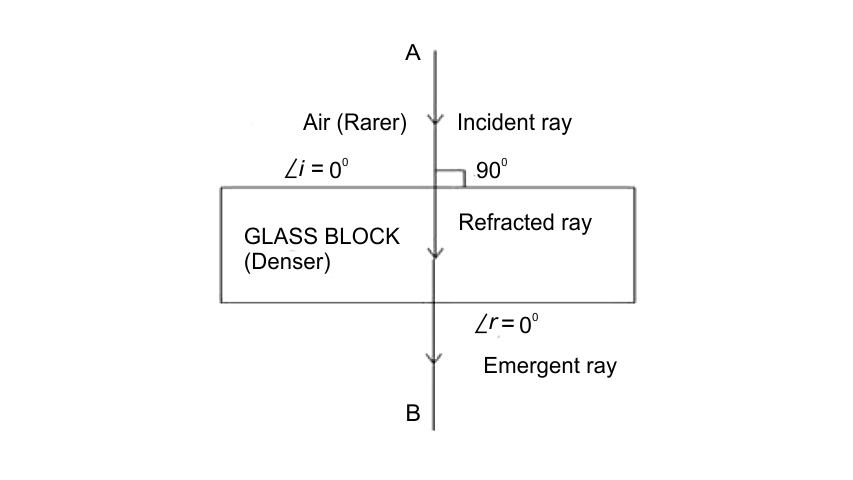
Case (ii) When angle of incidence is 45o.
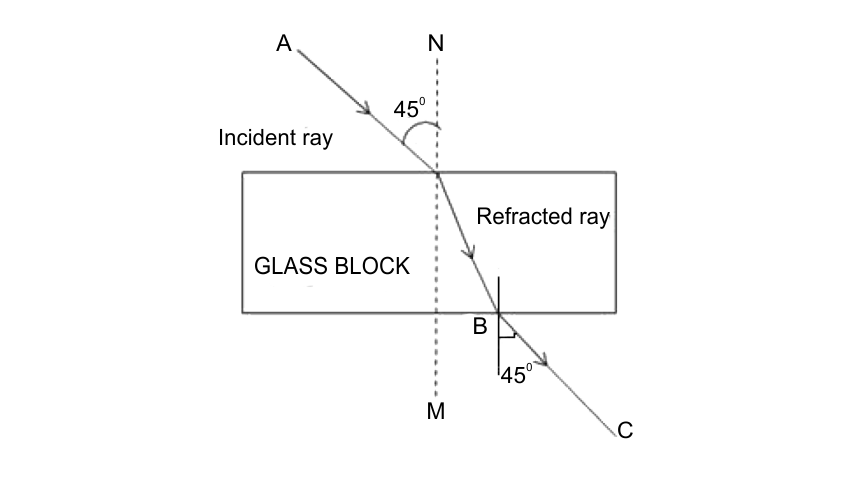
26. In the adjacent diagram, AO is a ray of light incident on a rectangular glass slab.
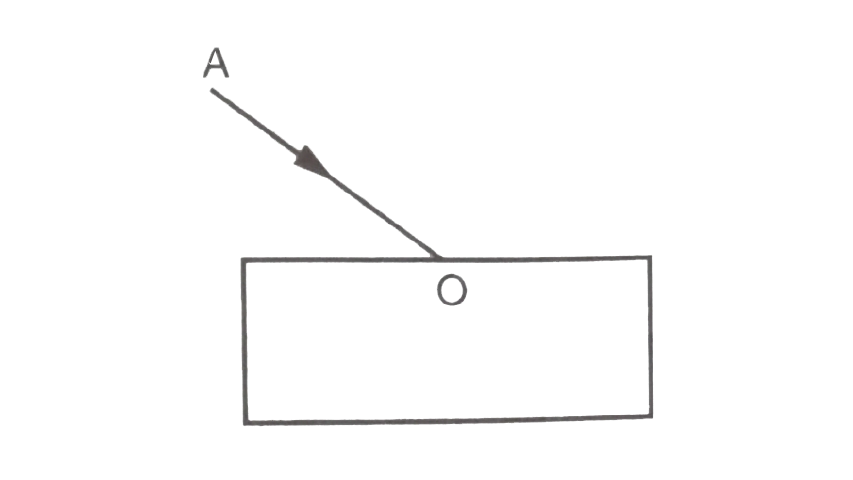
(a) Complete the path of the ray till it emerges from the slab.
Ans: (a) The figure shows below is complete path of the incident ray in the glass slab

(b) In the ray diagram, mark the angle of incidence (i) and the angle of (r) at the first interface. How is the refractive index of glass related to angles i and r?
Ans: Angle of incidence (i) and angle of refraction (r) are mentioned in part (a).
Relation between refractive index (μ) of glass and angles, as
Sin i / Sin r =μ
(c) Mark angle of emergence by the letter e. How are the angles i and e related?
Ans: Angle of emergence (e) is mention in part (a)
Relation between two angles are,
$\angle i=\angle r$
(d) Which two rays are parallel to each other? Name them.
Ans: Incident ray and emergent ray are parallel to each other.
(e) Indicate in the diagram the lateral displacement between the emergent ray and the incident ray. State one factor that affects the lateral displacement.
Ans: Lateral displacement is shown by XY in the figure. The lateral displacement of light as it travels through a rectangular glass slab is affected by the thickness of the glass block, the angle of incidence, and the refractive index of glass.
27. A ray of green light enters a liquid from air, as shown in the figure. The angle 1 is 45o and angle 2 is 30o.
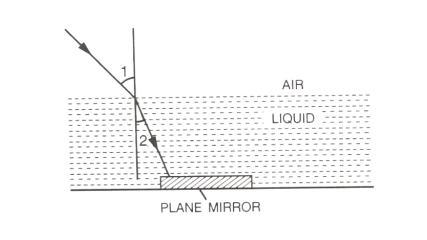
(a) Find the refractive index of liquid.
Ans: (a) The refractive index of the liquid, a μ i = sin 𝑖 / sin 𝑟
a μ i = sin 45° / sin 30°
= 1×2/1 ×√2 = √2 = 1.414
(b) Show in the diagram the path of the ray after it strikes the mirror and re-enters in air. Mark in the diagram the angles wherever necessary.
Ans:
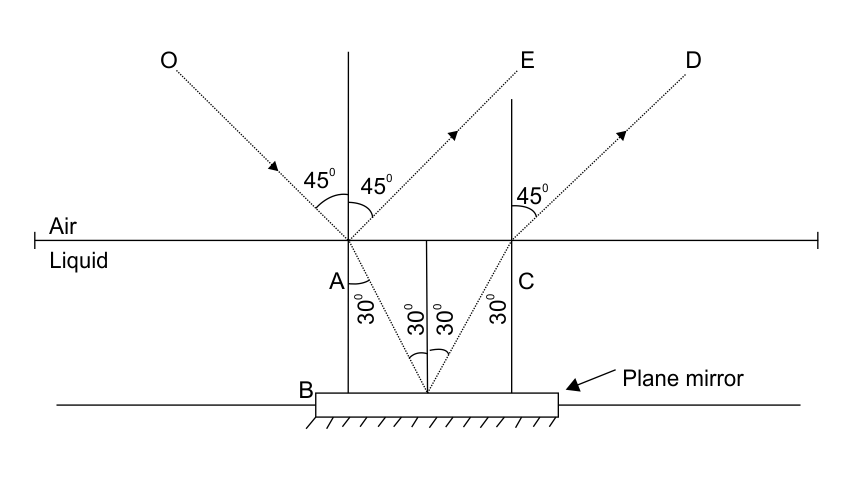
(c) Redraw the diagram if the plane mirror becomes normal to the refracted ray inside the liquid. State the principle used.
Ans:
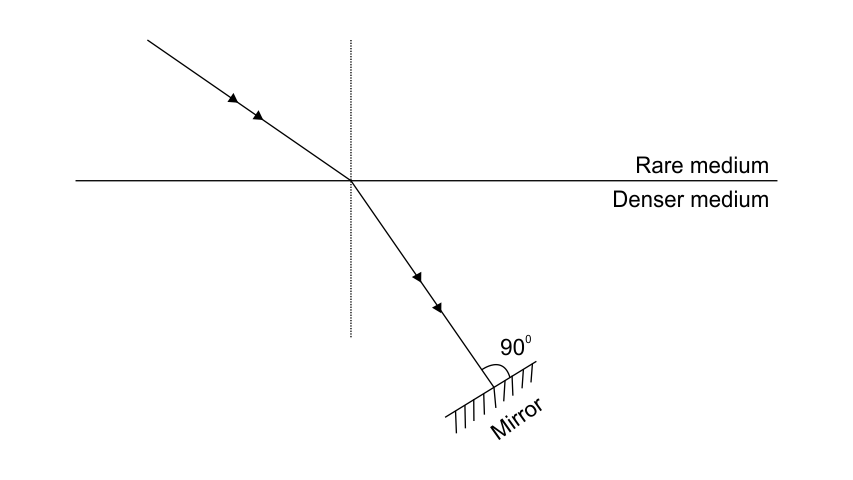
Here the 'Principle of Reversibility' is used.
28. When an illuminated object is held in front of a thick plane glass mirror, several images are seen, out of which the second image is the brightest. Give a reason.
Ans: When a ray of light from a lighted candle falls on the surface of a thick plane glass mirror, a very small part of light rays (approx 4%) is reflected and forming the first image which is virtual and faint image, while a large part of light (nearly 96%) is refracted inside the glass. Now this ray is strongly reflected back by the silvered surface inside the glass. This ray is partially refracted in air and this refracted ray forms another virtual image. Its image is the brightest image because it is due to the light suffering a strong reflection at the silver surface.
29. Fill in the blanks to complete the following sentences:
(a) When light travels from a rarer to a denser medium, its speed ………………….
Ans: When ray of light travels from a rarer to a denser medium, its speed decreases.
(b) When light travels from a denser to a rarer medium, its speed ………………….
Ans: When a ray of light travels from a denser to a rarer medium, its speed increases.
(c) The refractive index of glass with respect to air is 3/2. The refractive index of air with respect to glass will be ………………….
Ans: The refractive index of glass with respect to air will be 3/2 and the refractive index of air with respect to glass will be ⅔
Multiple Choice Type:
1. When a ray of light from air enters a denser medium, it:
(a) Bends away from the normal
(b) Bends towards the normal
(c) Goes undeviated
(d) Is reflected back
Ans: The correct option is (b).
Because the speed of light decreases in the denser medium due to it bends towards the normal.
2. A light ray does not bend at the boundary in passing from one medium to the other medium if the angle of incidence is:
(a) 0°
(b) 45°
(c) 60°
(d) 90°
Ans: The correct option is (a).
Reason: A ray of light which is incident perpendicular (i.e. at angle of incidence = 0°) on the surface separating the two media, goes undeviated.
3. The highest refractive index is of:
(a) Glass
(b) Water
(c) Diamond
(d) Ruby
Ans: The correct option is (c).
The speed of light in diamond is the least because the refractive index of diamond is highest.
Numericals:
1. The speed of light in air is 3 x 108 m s-1. Calculate the speed of light in glass. The refractive index of glass is 1.5.
Ans: Given, Speed of light in air is, c = 3 × 108 m/s
Refractive index of glass, μ = 1.5
Speed of light in glass, v = ?
We know that, μ = c/v
$\therefore \text{ v=3 }\!\!\times\!\!\text{ 1}{{\text{0}}^{8}}m/s/1.5$
v = 2 × 108 m/s
2. The speed of light in diamond is 125,000 km s-1. What is the refractive index? (speed of light in air = 3 x 108 m s-1).
Ans: Given, Speed of light in diamond is, v = 125 × 106 m/s
Speed of light in air, c = 3 × 108 m/s
Refractive index of diamond, μD = ?
We know that,
μ = c/v
$\therefore \text{ }\mu \text{=3 }\!\!\times\!\!\text{ 108m/s/125 }\!\!\times\!\!\text{ 106m/s}$
= 2.4
3. The refractive index of water with respect to air is 4/3. What is the refractive index of air with respect to water?
Ans: Given =, refractive index of water w.r.t. Air
airμwater = 4 / 3
$\therefore \text{ refractive index of air with respect to water,}_{{water\;\mu \;glass}}=\text{ }1{{/}_{air\mu \;water}}$
= 3 / 4
= 0.75
4. A ray of light of wavelength 5400 Ao suffers refraction from air to glass. Taking aμg= 3/2, find the wavelength of light in glass.
Ans: Given, refractive index of glass w.r.t. Air,
aμg = 3 / 2
Also, aμg = wavelength of light in air / wavelength of light in glass
\[\therefore 3\text{ }/\text{ }2~=\text{ }wavelength\text{ }of\text{ }light\text{ }in\text{ }air\text{ }/\text{ }wavelength\text{ }of\text{ }light\text{ }in\text{ }glass\]
\[\Rightarrow \text{ 3/2=5400/wavelength of light in glass}\]
\[\Rightarrow \text{ wavelength of light in glass = 2/3 }\!\!\times\!\!\text{ 5400=3600}\]
Exercise-4(B)
1. What is a prism? With the help of a diagram of a prism, indicate its refracting surfaces, refracting edges and base.
Ans:
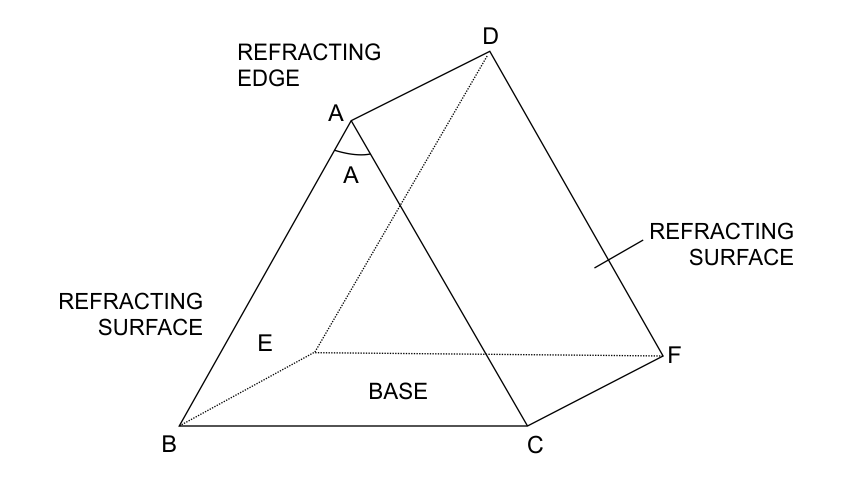
A prism is a transparent refracting medium which is bounded by five plane surfaces inclined at some angle.
2. The diagrams (a) and (b) in Fig. below shows the refraction of a monochromatic ray of light through a parallel sided glass block and prism, respectively.
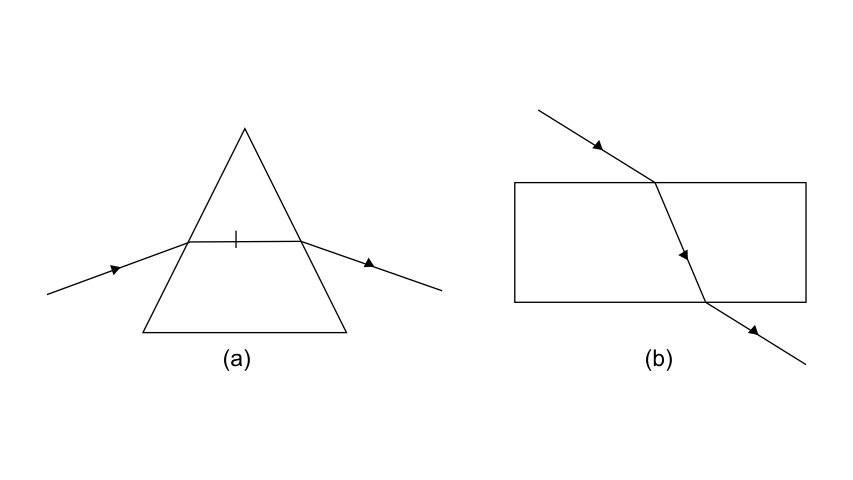
(a) In each diagram, label the incident, refracted, emergent rays and the angle of deviation.
Ans:
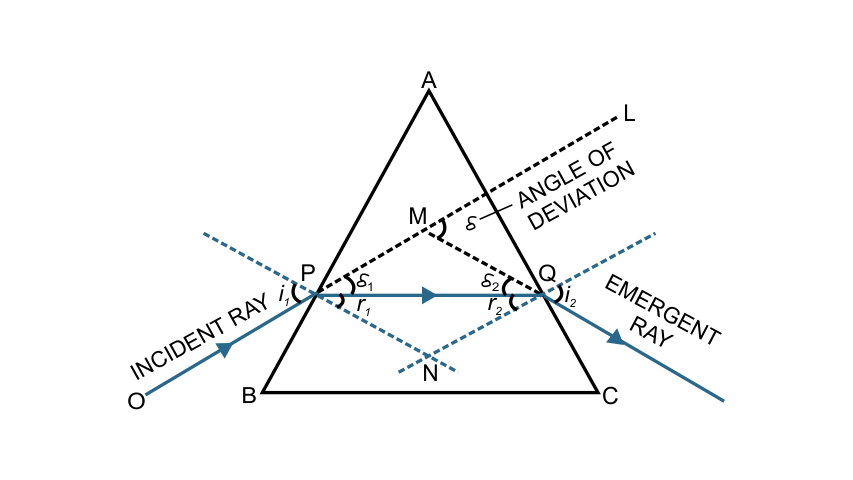

(b) In what way does the direction of the emergency ray in the two cases differ with respect to the incident ray? Explain your answer.
Ans: For prisms, the emergent ray is not parallel to the incident ray but for the glass they are parallel because, in a prism, refraction takes place at two inclined surfaces while in a glass block refraction takes place at two parallel surfaces
3. Define the term angle of deviation.
Ans: The angle between the emergent ray and the direction of the incident ray, is called the angle of deviation.
4. Complete the following sentence:
Angle of deviation is the angle which the ________ ray makes with the direction of ________ ray.
Ans: Angle of deviation is the angle which the emergent ray makes with the direction of the incident ray.
5. What do you understand about the deviation produced by a prism? Why is it caused? State three factors on which angle of deviation depends.
Ans: In a prism the ray of light suffers refraction at two surfaces. The prism produces deviation at the first surface and another deviation at the second surface. So, a prism produces a deviation and the value of the angle of deviation (or the deviation produced by a prism) depends on the following four factors:
(a) The angle of incidence (i),
(b) The material of prism (i.e., on refractive index μ),
(c) The angle of prism (A),
(d) The colour or wavelength (ƛ) of light used.
6(a). How does the angle of deviation produced by a prism change with increase in the angle of incidence? Draw a curve showing the variation in the angle of deviation with the angle of incidence at a prism surface.
Ans: As the angle of incidence increases, the angle of deviation decreases first and reaches a minimum value (𝜹m) for a certain angle of incidence. On increasing the angle of incidence, the angle of deviation is found to increase.
Variation of angle of deviation (𝜹) with angle of incidence(i) is show below:
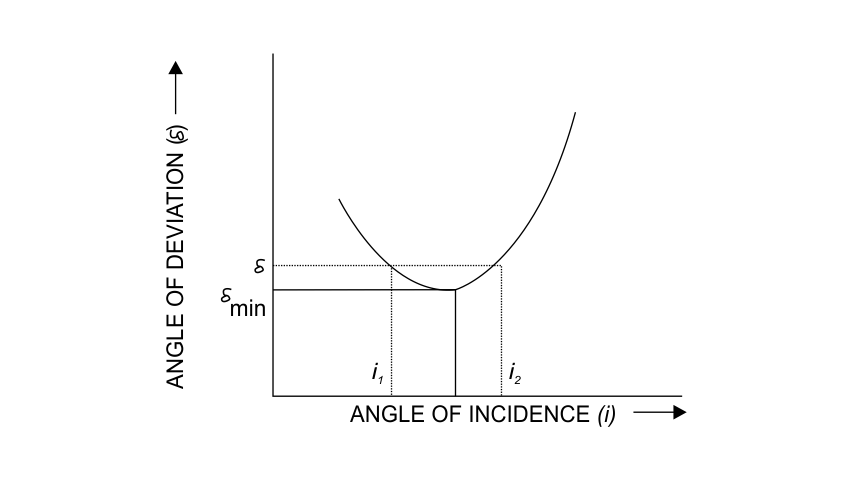
(b) Using the curve in part (a) above, how do you infer that for a given prism, the angle of minimum deviation δmin is unique for the given light.
Ans: For a given prism and colour of light, the angle of minimum deviation is unique if only one horizontal line can be drawn parallel to the i-axis at the lowest point of i-𝜹curve.
7. State whether the following statement is 'true' or 'false'. The deviation produced by a prism is independent of the angle of incidence and is same for all the colours of light.
Ans: False. On increasing in the angle of incidence, the angle of deviation first decreases and then increases.
A given prism deviates the violet light most while least the red light.
8. How does the deviation produced by a prism depend on
(i) The refraction index of its material
Ans: (i) For a given angle of incidence, the prism with a higher refractive index produces a greater deviation than a prism with a lower refractive index.
(ii) The wavelength of incident light
Ans: The refractive index of a medium is different for different colours of light. It increases with decrease in wavelength. Thus, the refractive index of the material of the prism is maximum for violet and least for red light. Hence, the prism deviates violet light most and least the red light, i.e.,
δviolet > δred.
9. How does the angle of minimum deviation produced by a prism change with increase in
(i) The wavelength of incident light ?
Ans: Changes in the angle of deviation if we increase the wavelength of incident light.
As we increase the wavelength, the angle of deviation decreases.
(ii) The refracting angle of the prism?
Ans: The angle of deviation increases with the increase in the angle of the prism.
10.Write a relation for the angle of deviation(𝜹) for a ray of light passing through an equilateral prism in terms of angle of incident (i), angle of emergence (e), angle of prism (A).
Ans: The relation between the angle of incident (i), angle of prism (A), angle of emergence (e) and angle of deviation (𝜹) for a ray of light passing through an equilateral prism is,
𝜹=(i + e) – A
11. A ray of light incident at an angle of incidence i1 passes through an equilateral glass prism such that the refracted ray inside the prism is parallel to its base and emerges at an angle of emergence i2.
(i) How is the angle of emergence 'i2' related to the angle of incidence 'i1'.
Ans: (i) i2 = i1
(ii) What can you say about the angle of deviation in such a situation?
Ans: Angle of deviation is minimum
In the minimum deviation state, the refracted ray inside the prism travels parallel to the base of the prism if the prism is equilateral and the angle of incidence is equal to the angle of emergence.
12. Draw a ray diagram to show the refraction of a monochromatic ray through a prism when it suffers minimum deviation. How is the angle of emergence related to the angle of incidence in this position?
Ans: In case of an equilateral prism, when the prism is in the position of minimum deviation = 𝜹min , the angle of incidence i1 is equal to the angle of emergence i2
i1=i2=i

13. A light ray of yellow colour is incident on an equilateral glass prism at an angle of incidence equal to 48o and suffers minimum deviation by an angle of 36o.
(i) What will be the angle of emergence?
Ans: (i) As the ray is suffering minimum deviation in an equilateral glass prism so
i1=i2
I2 = 48o
(ii) If the angle of incidence is changed to (a) 30 degree, (b) 60 degree, state whether the angle of deviation will be equal to less than or more than 36o.
Ans: If the angle of incidence is change to
(a) 30o then the angle of deviation will be more than 36o.
(b) 60o then the angle of deviation will be more than 36o.
14. Name the colour of white light which is deviated (i) the most, on passing through a prism.
Ans: Violet colour deviates most
(ii) The least, on passing through a prism.
Ans: Red colour deviates least.
15. Which of the two prisms, A made of crown glass and B made of flint glass, deviate a ray of light more?
Ans: B made of flint glass. Because the refractive index of flint glass is higher.
16. How does the angle of deviation depend on the refracting angle of the prism?
Ans: The angle of deviation (𝜹) increases on increasing the angle of prism (A).
17. An object is viewed through a glass prism with its vertex pointing upwards. Draw a ray diagram to show the formation of its image seen by the observer.
Ans: If two rays OL and OA from a source O are incident on the prism after that They refracted along LM and AB from the first face of the prism after that they refract again from the second face of the prism and emerge out along BC and MN respectively such that they appear to come from I.
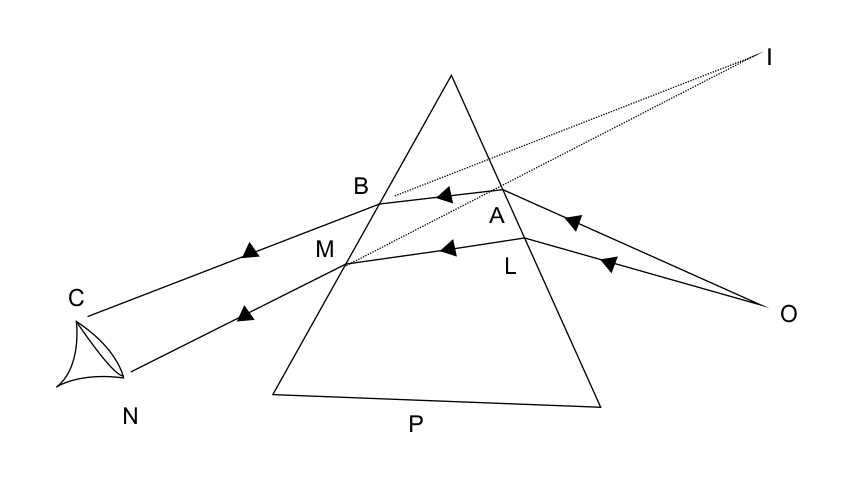
Now, the observer will see the object O raised at the position I.
18. A ray of light is normally incident on one face of an equilateral glass prism. Answer the following
(a) What is the angle of incidence on the first face of the prism?
Ans: (a) If the incident ray of light incident normally to the prism then angle of incidence will be 0o.
(b) What is the angle of refraction from the first face of the prism?
Ans: In this case, from the first face the angle of refraction will be r1= 0o.
(c) What will be the angle of incidence at the second face of the prism?
Ans: Prism is an equilateral triangle, So A=60o and r1=0o. So, the angle of incidence at the second face of the prism will be 60o.
(d) Will the light ray suffer minimum deviation by the prism?
Ans: No, the ray of light does not suffer minimum deviation.
19. The diagram below shows two identical prisms A and B placed with their faces parallel to each other. A ray of light of single colour PQ is incident at the face of the prism A. Complete the diagram to show the path of the ray till it emerges out of the prism B.
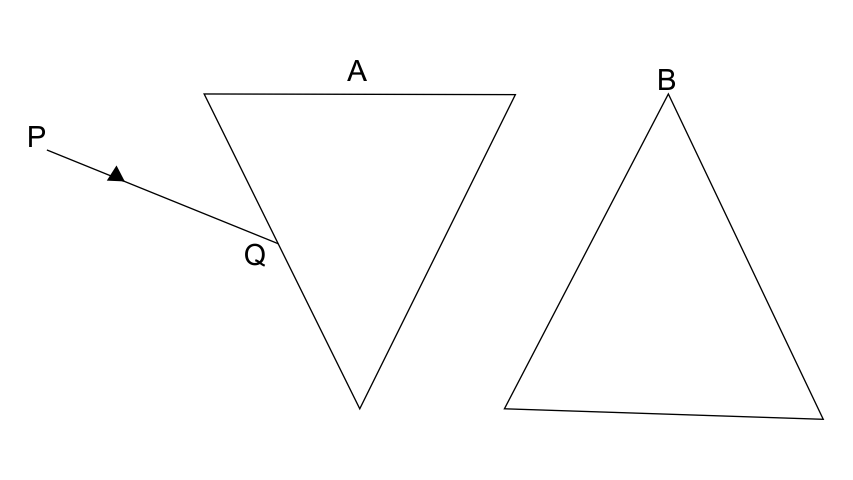
(Hint: The emergent ray out of the prism B will be parallel to the incident ray PQ)
Ans:
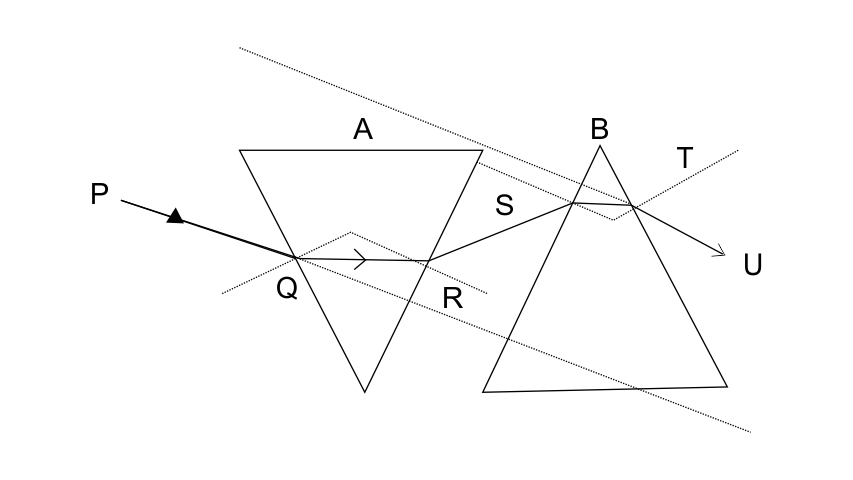
Multiple Choice Type:
1. In refraction of light through a prism, the light ray:
(a) Suffers refraction only at one face of the prism
(b) Emerges out from the prism in a direction parallel to the incident ray
(c) Bends at both the surfaces of prism towards its base
(d) Bends at both the surfaces of the prism opposite to its base.
Ans: The correct option is (c), The ray of light bends at both the surfaces of the prism towards its base.
2. A ray of light suffers refraction through an equilateral prism. The deviation produced by the prism does not depend on the:
(a) Angle of incidence
(b) Colour of light
(c) Material of prism
(d) Size of prism
Ans: The correct option is (d).
The deviation produced by the prism will not depend on the size of the prism.
Numericals:
1. A ray of light incident at an angle 48o on a prism of refracting angle 60o suffers minimum deviation. Calculate the angle of minimum deviation.
(Hint: δmin = 2i - A)
Ans: Given information, Angle of incidence, i = 48°
Refracting angle, A = 60°
Angle of minimum deviation, δmin =?
We know that, δmin = 2i – A
δmin = 2(48) – 60
δmin = 36°
2. What should be the angle of incidence for a ray of light which suffers a minimum deviation of 36o through an equilateral prism?
(Hint: A = 60°, i = (A + δmin)/2)
Ans: Given information, Angle of prism, A = 60°
Angle of minimum deviation, = 36°
Angle of incidence, i =?
We know that, δmin = 2i – A
36° = 2i – 60
i = 48°
Exercise-4(C)
1. How is the refractive index of a medium related to the real and apparent depths of an object in that medium?
Ans: Refractive index μ related with real and apparent depths as;
μ = Real depth / Apparent Depth
2. Prove that
Refractive index = Real depth / Apparent Depth
Ans:
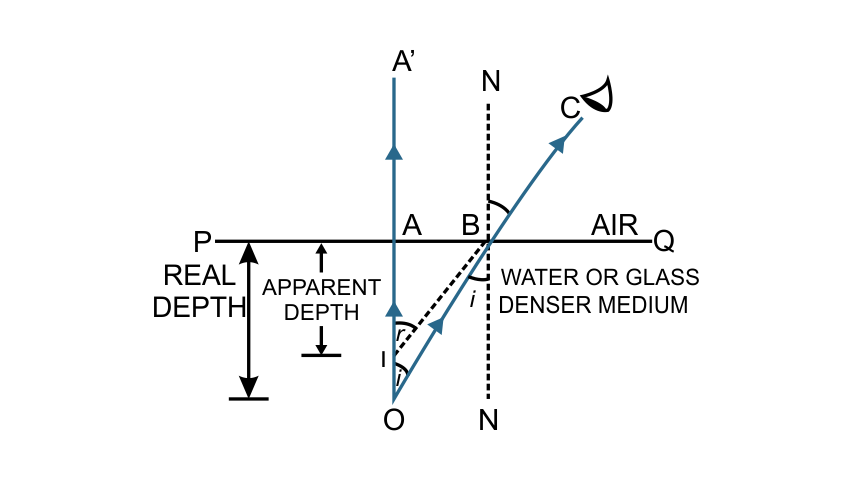
Let a ray of light incident normally along OA then it will pass straight along OAA'. Let another ray of light from O (the object) is an OB incident at an angle i then after refraction it passes along BC. On extending this ray of light BC backwards, it will appear to come from the point I, and hence, distance AI will represent the apparent depth, which is less than the real depth AO.
Since BN’ and AO are parallel and OB is the transversal,
$\angle AOB=\angle OBNI(Alternate\text{ angles)}$
\[Sin\text{ }{{i}_{c}}=\text{ }1/\mu =\text{ }1\text{ }/1.5\text{ }=\text{ }0.667\text{ }{{i}_{c}}=\text{ }41.8\text{ }\approx \text{ }42{}^\circ \]
In ∆BAO, Sin i = 𝐵𝐴 / 𝑂𝐵
In ∆IAB, Sin r = 𝐵𝐴 𝐼𝐵
Because, refractive index of air w.r.t the medium is,
aµm = sin 𝑖 / sin 𝑟 = 𝐵𝐴×I𝐵 / 𝐵𝐴×O𝐵 = 𝐼𝐵 / 𝑂𝐵
\[\therefore \text{ }Refractive\text{ }index\text{ }of\text{ }medium\text{ }w.r.t.\text{ }air\text{ }is,{{\text{ }}_{a}}{{\mu }_{m}}=\text{ }1\text{ }{{/}_{a}}{{\mu }_{m}}=\text{ OB/IB}\]
The point B is very close to the point A, i.e the object is viewed from a point vertically above the object.
\[\therefore \text{ IA = IB and OB = OA}\text{.}\]
So, we can say that, aµm = 𝑂𝐴 / 𝐼𝐴 = Real depth/ Apparent depth
3. A tank of water is viewed normally from above.
(a) State how the depth of the tank appears to change.
Ans: The depth of the tank will appear to be smaller than its real depth. This will happen because of refraction of light from a denser medium (water) to a rarer medium.
(b) Draw a labelled ray diagram to explain your answer.
Ans:

4. Water in a pond appears to be only three-quarters of its actual depth. (a) What property of light is responsible for this observation? Illustrate your answer with the help of a ray diagram.
Ans: 'Refraction of light' is responsible for it. When ray of light travels from a denser medium to a rarer medium, it bends away from the normal.
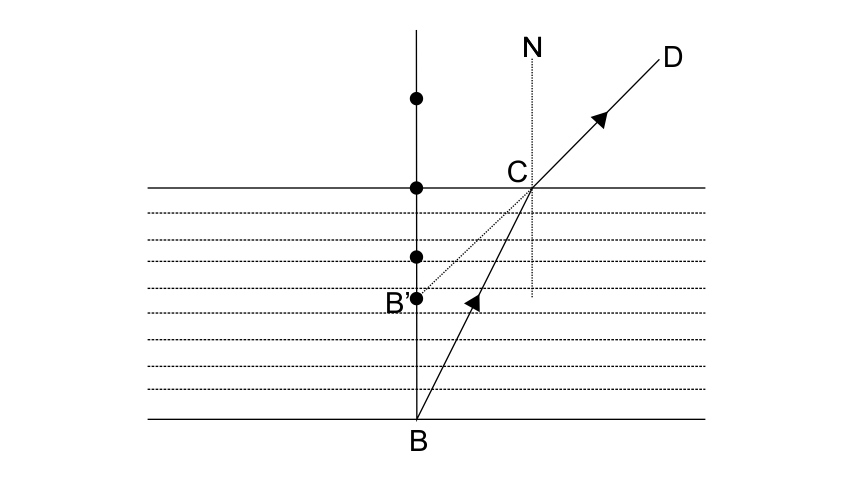
(b) How is the refractive index of water calculated from its real and apparent depths?
Ans: Let any object B be placed at the bottom of a pond. Assume a ray of light ray BC from the object that travels from water to air. After refraction from the water surface, the ray travels away from the normal N and follows the path CD on extending this ray of light CD backwards, it will appear to come from the point B' means a virtual image of the object B will appear at B'.
Refractive index, μ = Real depth / Apparent Depth
5. Draw a ray diagram to show the appearance of a stick partially immersed in water. Explain your answer.
Ans: A stick partially immersed in water in a glass container will appear shown in figure below.It will happen because the rays appear to come from P' (which is the virtual image of the tip P of the stick) due to medium (water) to rarer medium (air).
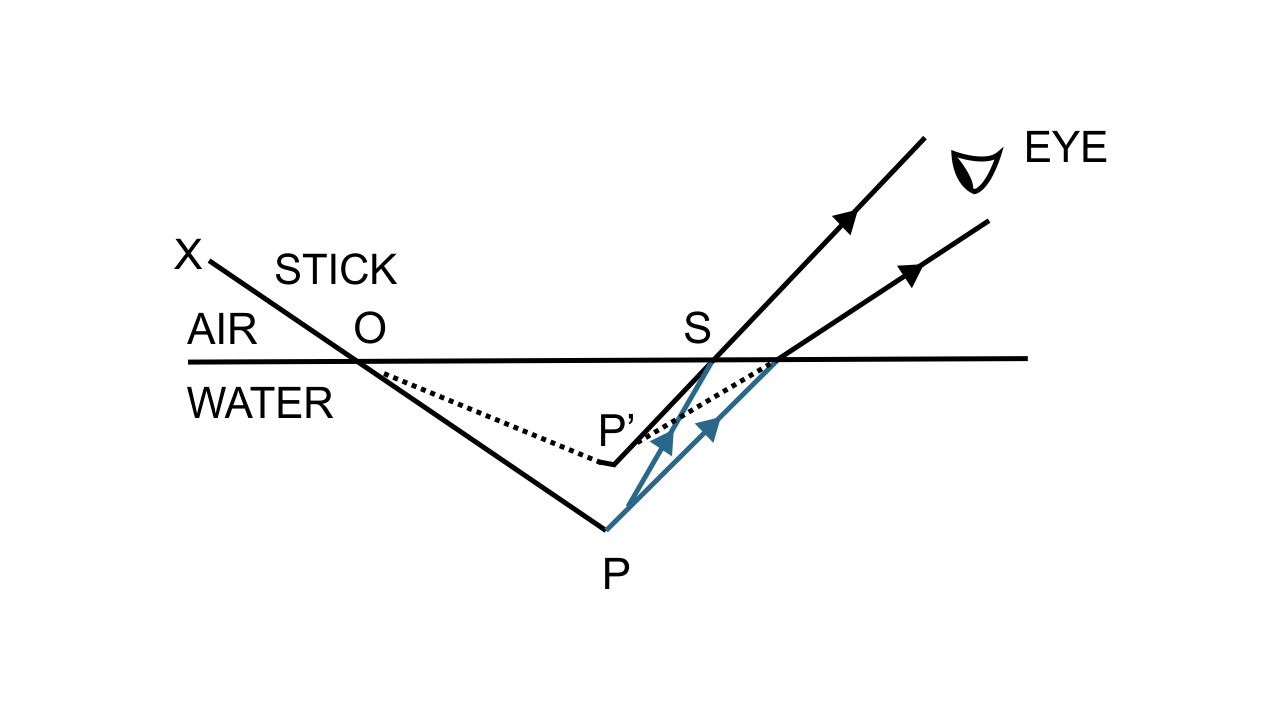
6. A fish is looking at a 1.0 m high plant at the edge of the pond. Will the plant appear shorter or taller than its actual height? Draw a ray diagram to support your answer.
Ans: The plant will appear taller than its actual height.
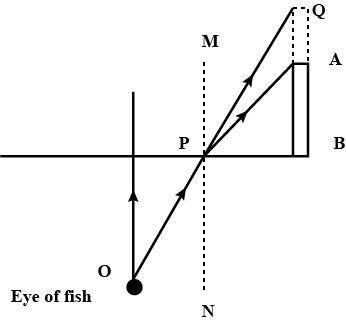
If the fish looks from the point O. As the ray OP emerges from water to air, it bends away from the normal MN because air is a rarer medium in comparison to water. But if we extend the ray OP then it will meet at point Q due to which the plant AB will look taller than its actual height.
7. A student puts his pencil into an empty trough and observes the pencil from the position indicated in the diagram alongside in Fig
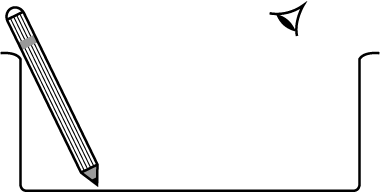
(i) What change will be observed in the appearance of the pencil when water is poured into the trough?
Ans: Part of the pencil which is immersed in water will look small and raised up.
(ii) Name the phenomenon which accounts for the above started observation.
Ans: The phenomenon which is responsible for this is refraction of light.
(iii) Complete the diagram showing how the student's eye sees the pencil through water.
Ans: The required figure is shown below;
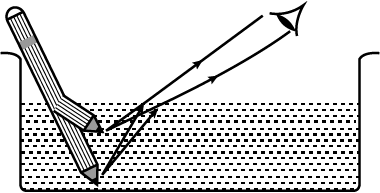
8. An object placed in one medium when seen from the other medium, appears to be vertically shifted. Name the factors on which the magnitude of shift depends, and state how it depends on them.
Ans: The factors on which the magnitude of shift depends are:
(a) The refractive index of the medium,
(b) The thickness of the denser medium and
(c) The colour (or wavelength) of incident light.
If we increase the refractive index of medium, then shift will also increase.
If we increase the thickness of a denser medium, then shift will also increase but if we increase in the wavelength of light used then shift will decrease.
Multiple Choice Type:
1. A small air bubble in a glass block when seen from above appears to be raised because of:
(a) Refraction of light
(b) Reflection of light
(c) Reflection and refraction of light
(d) None of the above
Ans: The correct answer is option (a).
Explanation- When a ray of light comes from denser to rarer medium, it bends away from the normal.
2. An object in a denser medium when viewed from a rarer medium appears to be raised. The shift is maximum for:
(a) Red light
(b) Violet light
(c) Yellow light
(d) Green light
Ans: The correct answer is option (b).
Explanation- The shift is maximum for violet light because the refractive index of glass is the most for the violet colour of light and apparent depth = (real depth)/(refractive index)
Numericals:
1. A water pond appears to be 2.7 m deep. If the refractive index of water is 4/3, find the actual depth of the pond.
Ans: Apparent depth = 2.7 m
µw = 4/ 3
Real depth = Apparent depth × µ
= 2.7 × 4 / 3
= 3.6 m
2. A coin is placed at the bottom of a beaker containing water (refractive index = 4/3) to a depth of 12 cm. By what height the coin appears to be raised when seen from vertically above?
Ans: Refractive index of the water, µw = 4/3
Real depth at which the coin is placed = 12 cm
Shift in the image = ?
Shift = real depth × (1 − 1 /)
Shift = 12 × (1 − 3 / 4)
R= 12 / 4
= 3cm
3. A postage stamp kept below a rectangular glass block or refractive index 1.5 when viewed from vertically above it, appears to be raised by 7.0 mm. Calculate the thickness of the glass block.
Ans: Refractive index of the glass block, µg = 1.5
Shift in the image = 7mm or 0.7 cm
Thickness of glass block or real depth = ?
Shift = Real depth × (1 − 1 /)
0.7 = R × (1 − 1 / 1.5)
R = 0.7 ×1.5 / 0.5
= 2.1 cm
Exercise-4(D)
1. Explain the term critical angle with the aid of a labelled diagram.
Ans: Critical angle: The angle of incidence in the denser medium at which the angle of refraction in the rarer medium is 90o is called the critical angle.
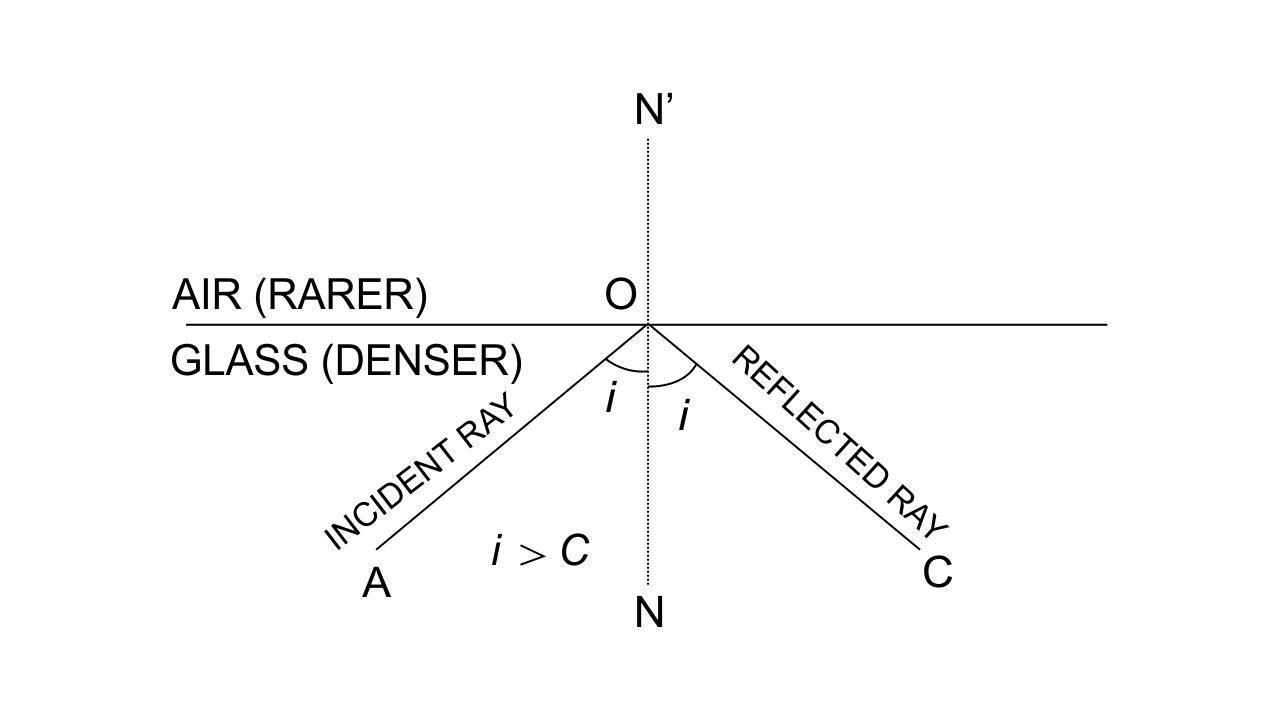
2. How is the critical angle related to the refractive index of a medium?
Ans: The relation between critical angle and refractive index of a medium is;
μ= 1/ sin ic = cosec ic
3. State the approximate value of the critical angle for
(a) glass-air surface
(b) water-air surface.
Ans: (a) In glass-air surface, For glass, refractive index aμg = 3/2
sin ic = 1/ aμg
= 2 / 3
𝑜 ic = 42°
(b) In water-air surface is For water, refractive index aμw= 4 / 3
\[\therefore sin\text{ }{{i}_{c}}=\text{ }{{1}_{a}}{{\mu }_{g}}\]= 3 / 4
𝑜𝑟 ic = 49°
4. What is the meaning of the statement 'the critical angle for diamond is 24°?
Ans: The critical angle for diamond is 24° it implies that at an incident angle of 24° within the diamond the angle of refraction in the air becomes 90° And if the incident angle will be more than this angle then total internal reflection will happen without any refraction.
5. A light ray is incident from a denser medium on the boundary separating it from a rarer medium at an angle of incidence equal to the critical angle. What is the angle of refraction for the ray?
Ans: When a ray is incident from a denser medium to a rarer medium at angle equal to critical angle (i=ic), the angle of refraction will be 90°.
6. Name two factors which affect the critical angle for a given pair of media. State how the factors affect it.
Ans: The factors which effect on the critical angle are:
(i) Effect of colour of light: The critical angle for a pair of mediums is lesser for the violet and more for the red light of ray. So, the critical angle increases on increasing the wavelength of light.
(ii) Effect of temperature: The critical angle increases on increasing in temperature because on increasing the temperature of medium, its refractive index will decrease.
7. The critical angle for glass-air is 45° for the light of yellow colour. State whether it will be less than, equal to, or more than 45° for (i) red light, (ii) blue light?
Ans: If the wavelength decreases (or increases) then refractive index becomes more (or less) and critical angle becomes less (or more).
(i) For red light it will be more than 45° and
(ii) For blue light it will be less than 45°.
8. Which colour of light has a higher critical angle? Red light or green light.
Ans: The critical angle of red light is more than that of green light.
9. (a) What is total internal reflection?
Ans: (a) Total internal reflection: It is the phenomenon when a ray of light travelling in a denser medium, is incident at the surface of a rarer medium such that the angle of incidence is more than the critical angle for the pair of media then the ray is totally reflected back into the denser medium.
(b) State two conditions necessary for total internal reflection to occur.
Ans: There are two necessary conditions for total internal reflection:
i.e. The ray of light should travel from a denser medium to a rarer medium.
ii. The angle of incidence should be greater than the critical angle for the pair of media.
(c) Draw diagrams to illustrate critical angle and total internal reflection.
Ans: When incidence angle is more than critical angle i.e., in case of total internal reflection.

10. Fill in the blanks to complete the following sentences:
(a) Total internal reflection occurs when a ray of light passes from a ………………..medium to a …………………. Medium.
Ans: (a) Total internal reflection occurs when a ray of light passes from a denser medium to a rarer medium.
(b) Critical angle is the angle of ……………..in denser medium for which the angle of …………………in rarer medium is ………………
Ans: Critical angle is the angle of incidence in the denser medium for which the angle of refraction in the rarer medium is 90°.
11. State whether the following statement is true or false: If the angle of incidence is greater than the critical angle, light is not refracted at all, when it falls on the surface from a denser medium to a rarer medium.
Ans: It’s True.
12.The refractive index of air with respect to glass is expressed as,
gμa = sin i / sin r
(a) Write down a similar expression for gμa in terms of angle i and r.
Ans: (a) gμa = sin i / sin r
(b) If angle, r=90°, what is the corresponding angle i called?
Ans: If the refractive angle, r=90o, the corresponding angle of incidence will be equal to the critical angle.
(c) What is the physical significance of the angle i and part (b)?
Ans: If the angle of incidence exceeds the value of i obtained in part (b) (i.e., critical angle), total internal reflection will happen.
13. Fig.4.61 below shows two rays A and B travelling from water to air. If the critical angle for water- air surface is 48°, complete the ray diagram showing the refracted rays for each. State conditions when the ray will suffer total internal reflection.
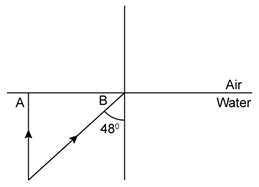
Ans:
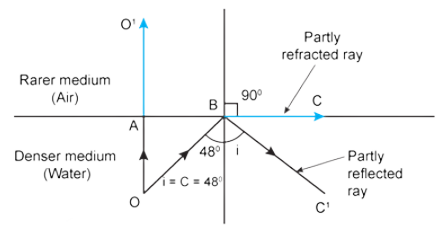
The necessary conditions for the total internal reflection are.
(i) Light should travel from a denser medium to a rarer medium.
(ii) The angle of incidence should be greater than the critical angle.
In this case, the angle of incidence, i >48o.
14. Fig. shows a point source P inside a water container. Three rays A, B and C starting from the source P are shown up to the water surface.
(a) Show in the diagram, the path of these rays after striking the water surface. The critical angle for the water-air surface is 48°.
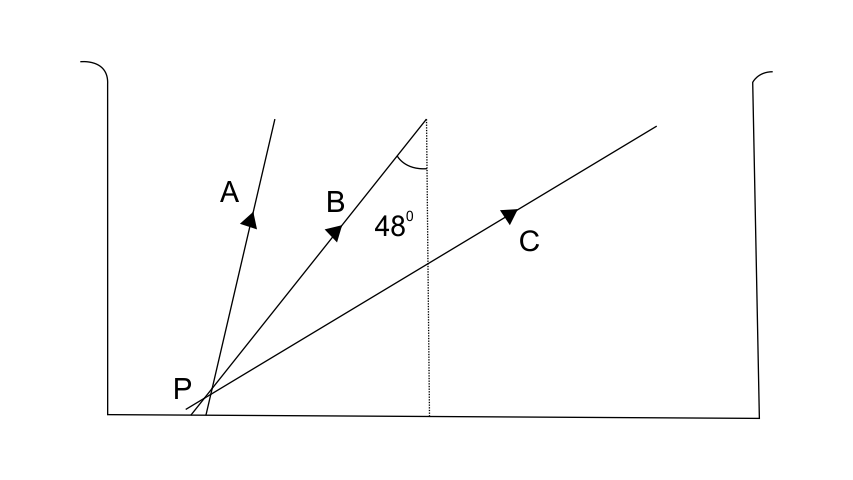
Ans:
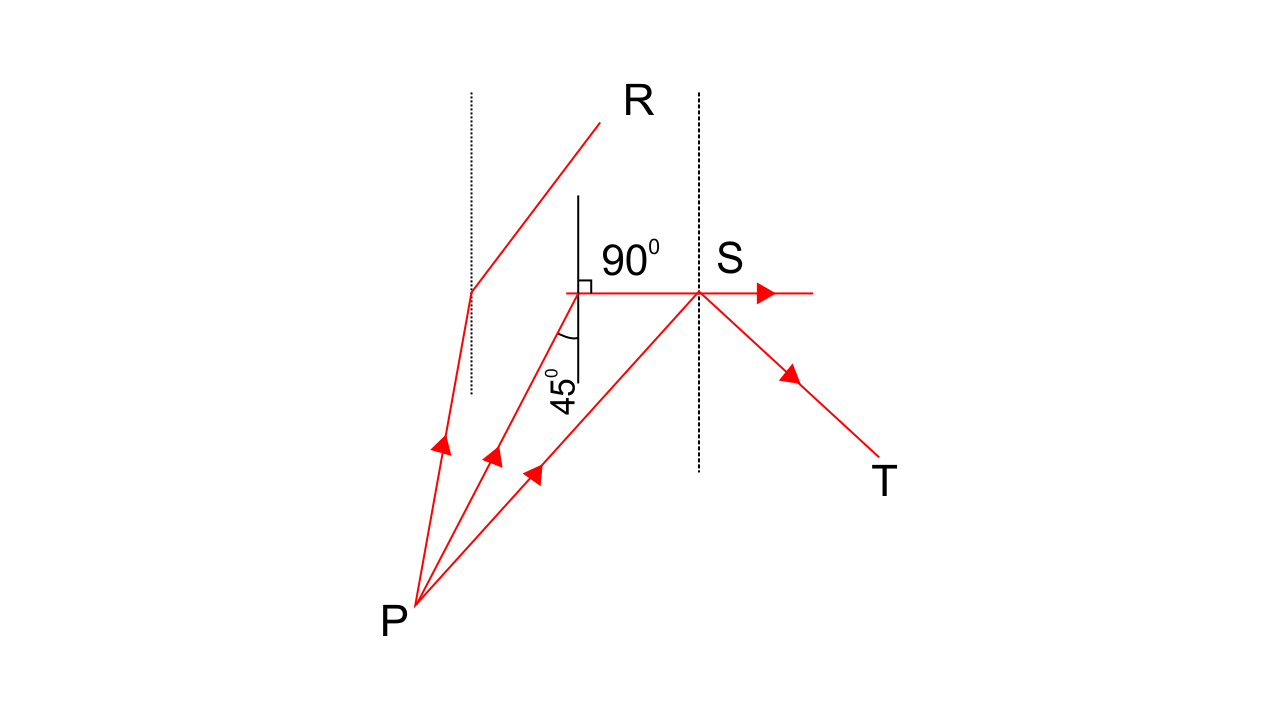
(b) Name the phenomenon which the rays A, B and C exhibit.
Ans: Rays A and B exhibit the phenomenon of 'refraction of light'.
And rays C exhibits the phenomenon of 'total internal reflection'.
15. In the figure, PQ and PR are the two light rays emerging from an object P. The ray PQ is refracted as QS.
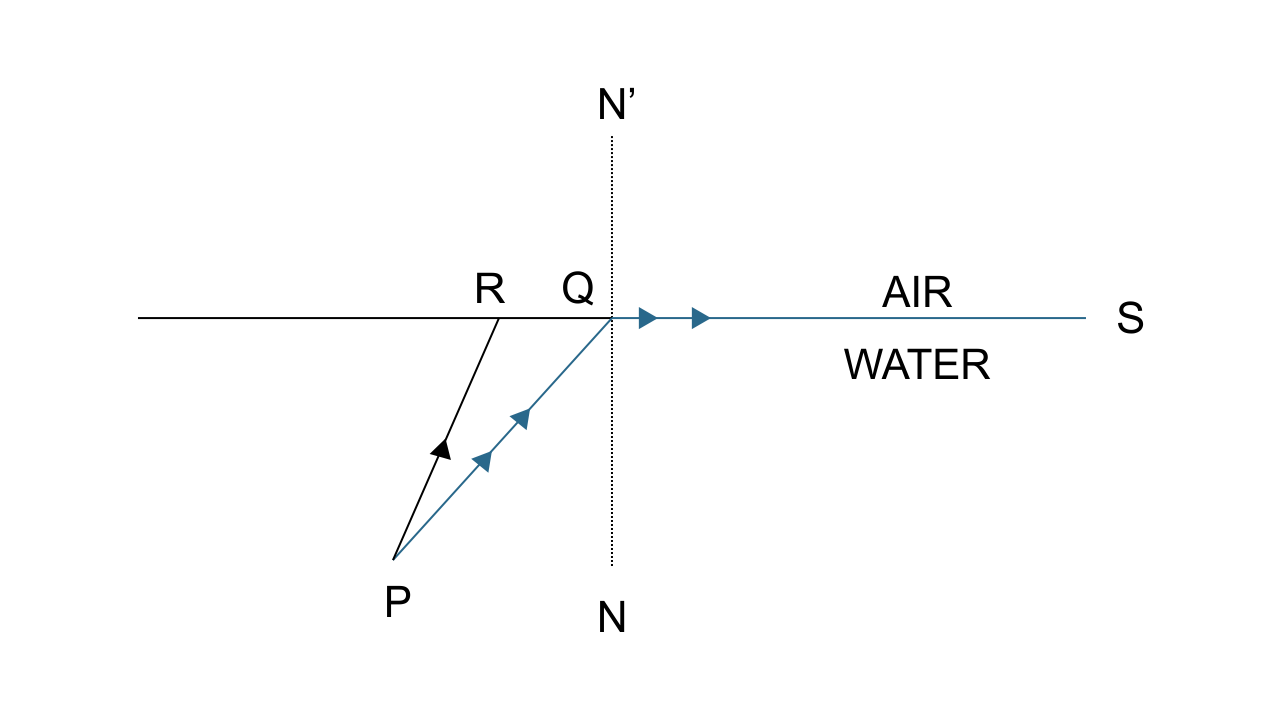
(a) State the special name given to the angle of incidence
Ans: Critical angle
Hint: The angle of incidence in the denser medium at which the angle of refraction in the rarer medium becomes 90o is called the critical angle.
(b) What is the angle of refraction for the refracted ray QS?
Ans: 90o
(c) Name the phenomenon that occurs if the angle of incidence ∠PQN has increased.
Ans: Total internal reflection.
When the angle of incidence is more than the critical angle, the phenomenon of total internal reflection will occur due to which the ray of light is not refracted but is reflected back into the same medium.
(d) The ray PR suffers partial reflection and refraction on the water-air surface. Give a reason.
Ans: For ray PR, the angle of incidence is less than the critical angle (i.e. <PQS); So, at the interface of two mediums according to the laws of reflection, ray PRwillo suffer partial reflection and refraction.
(e) Draw in the diagram the refracted ray for the incident ray PR and hence show the position of image of the object P by the letter P' when seen vertically from above.
Ans:
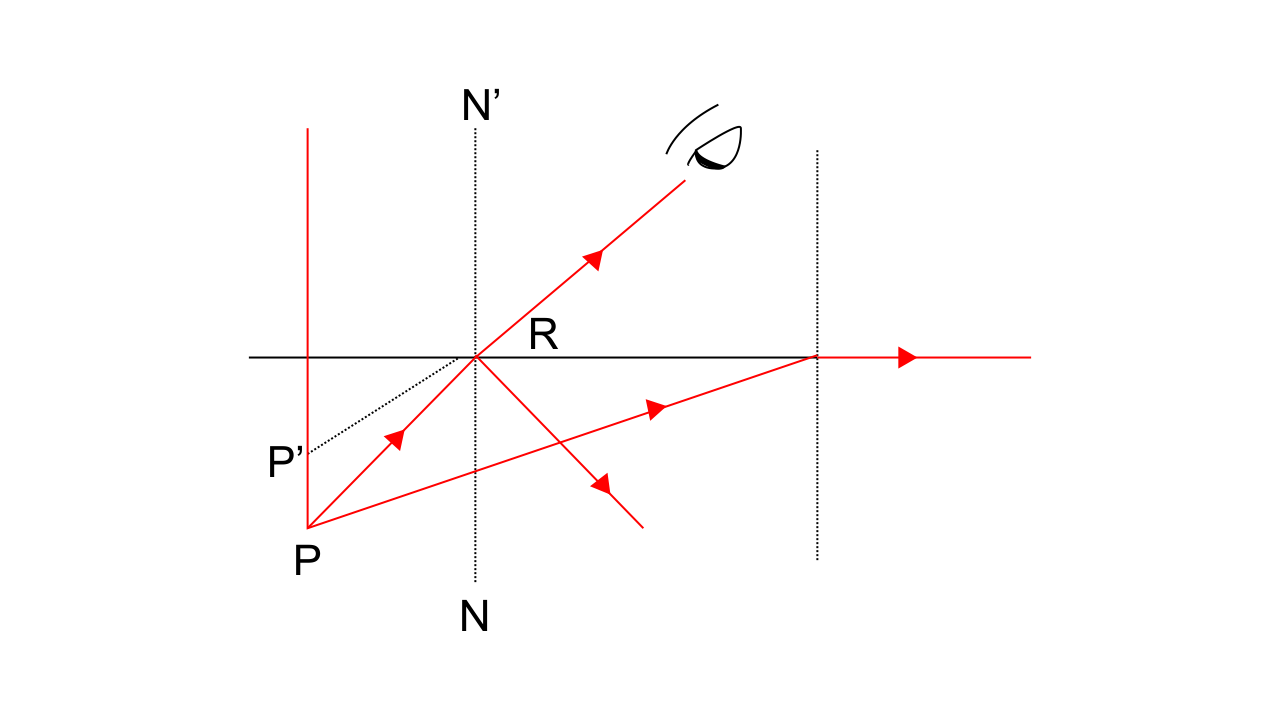
16. The refractive index of glass is 1.5. From a point P inside a glass block, draw rays PA, PB and PC incident on that glass-air surface at an angle of 30o, 42o and 60o respectively
(a) In the diagram show the approximate direction of these rays as they emerge out of the block.
Ans: (a) = 1.5
\[Sin\text{ }{{i}_{c}}=\text{ }1/\mu =\text{ }1\text{ }/1.5\text{ }=\text{ }0.667\text{ }{{i}_{c}}=\text{ }41.8\text{ }\approx \text{ }42{}^\circ \]
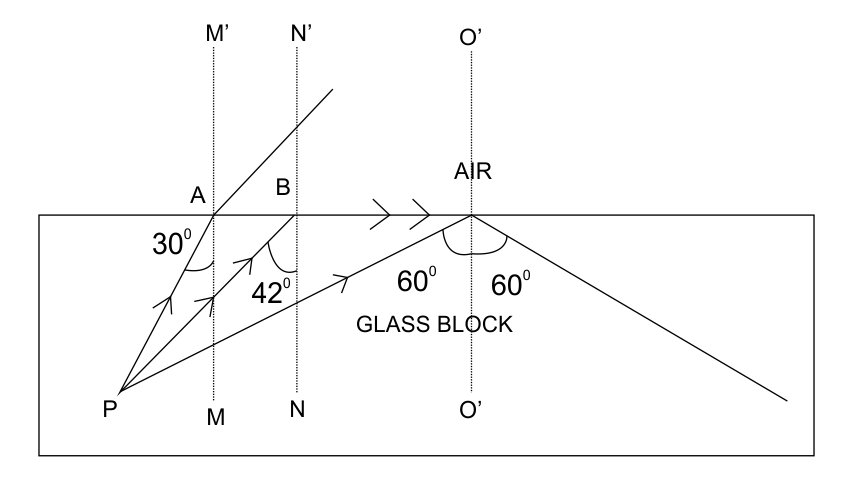
(b) What is the angle of refraction for the ray PB?
Ans: As angle of incidence inside glass block is 42°
Sin r / sin i = aµg
sin r = aµg × sin 42°
Take sin 42° = 2 / 3 and aµg= 3 / 2
Sin r = 3 /2 × 2 / 3 = 1
So, r = 90°
It means the ray PB incident at the critical angle
17. A ray of light enters a glass ABCD as shown in Fig. and strikes at the Centre O of the circular part AC of the slab. The critical angle of glass is 42°. Complete the path of the ray till it emerges out of the slab. Mark the angles in the diagram wherever necessary.
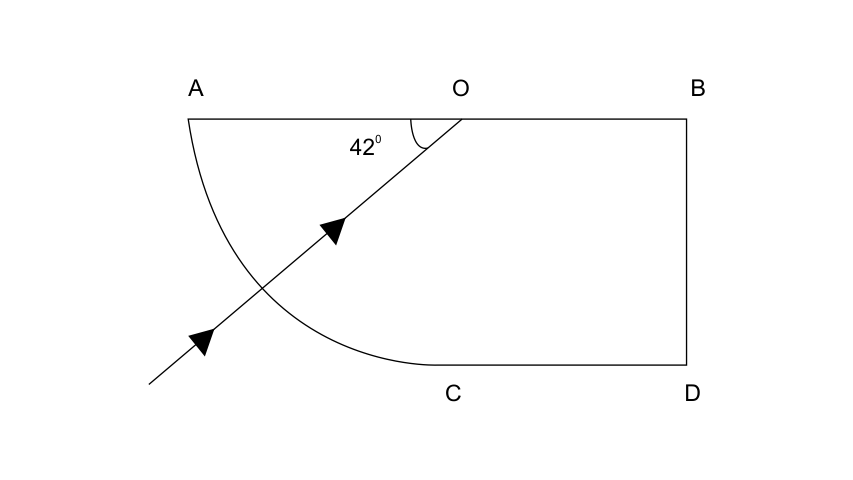
Ans:
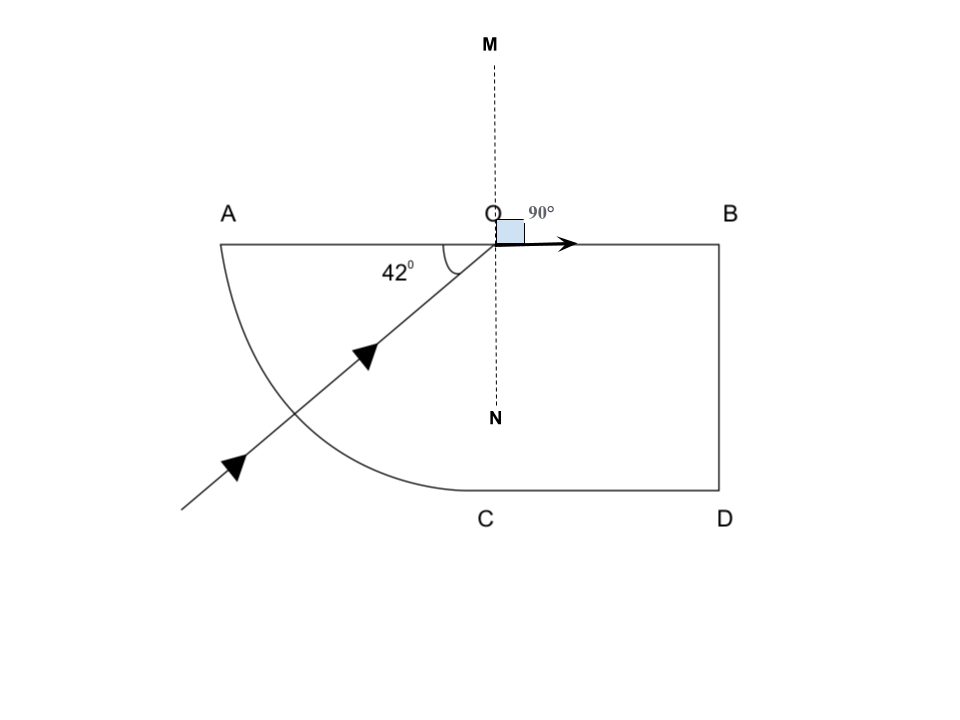
Ray is incident on the glass at its critical angle, So the angle of refraction will be 90°.
18. What is a total reflecting prism? State three actions that it can produce. Draw a diagram to show one action of the total reflecting prism.
Ans: A prism which has an angle of 90° between its two refracting surfaces and the other two angles each equal to 45°, is known as a total reflecting prism. The light incident normally on any of its faces will suffer total internal reflection inside the prism.
Due to this, a total reflecting prism is used to produce following three actions:
(a) To deviate a ray through 90°,
(b) To deviate a ray through 180°, and
(c) To erect the inverted image without producing deviation in its path.
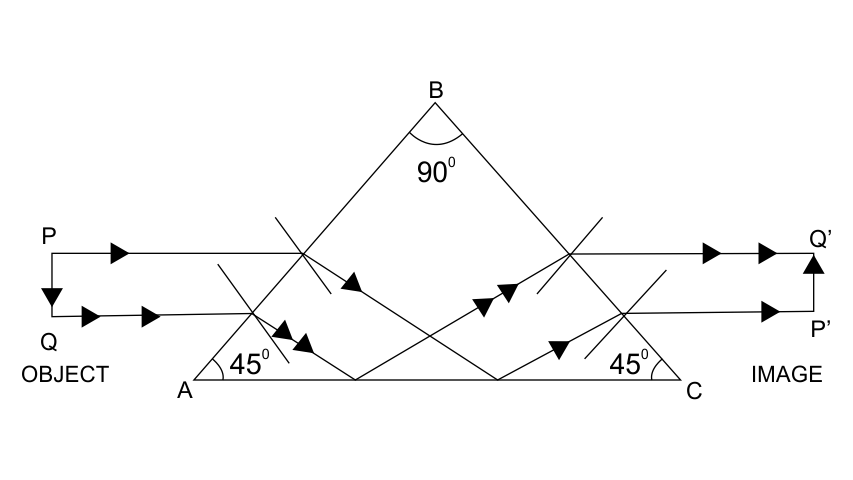
This is an erecting prism which is used to erect the inverted image without producing deviation in its path.
19. Show with the help of a diagram how a total reflecting prism can be used to turn a ray of light through 90°. Name one instrument in which such a prism is used.
Ans:
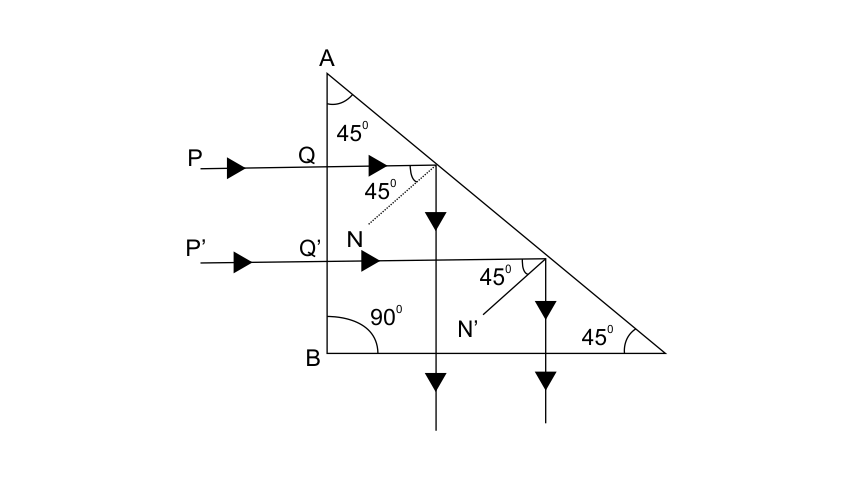
As shown in the figure, a beam of light is incident on face AB of the prism normally so it passes undeviated and it will strike the face AC where it makes an angle of 45° with the normal to AC. Because the incident angle is more than the critical angle so that the rays will suffer total internal reflection and reflect at an angle of 45° after that it strikes on face BC, where it is incident normally and it passes undeviated. Finally, the incident beam gets deviated through 90°. Such a prism is used in periscopes.
20. A ray of light OP passes through a right angled prism as shown in the adjacent diagram.
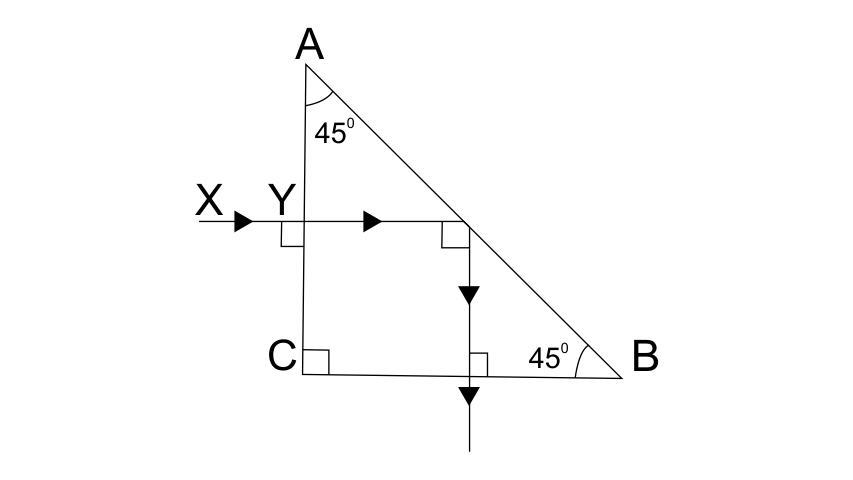
(a) State the angle of incidence at the faces AC and BC.
Ans: At face AC is 45° and at face BC is 0°.
(b) Name the phenomenon which the ray suffers at the face AC.
Ans: The ray will suffer total internal reflection at the face AC.
21. Draw a diagram of a right-angled isosceles prism which is used to make an inverted image erect.
Ans:
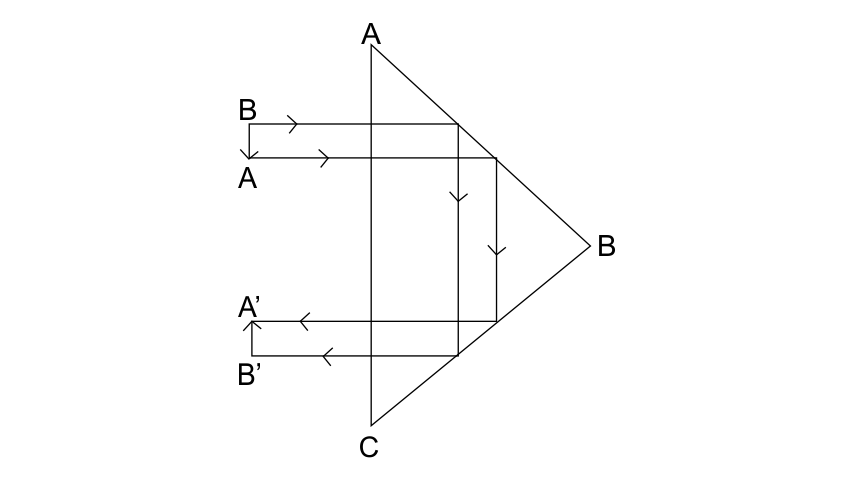
22. In Fig., a ray of light PQ is incident normally on the hypotenuse of an isosceles right angle prism ABC.
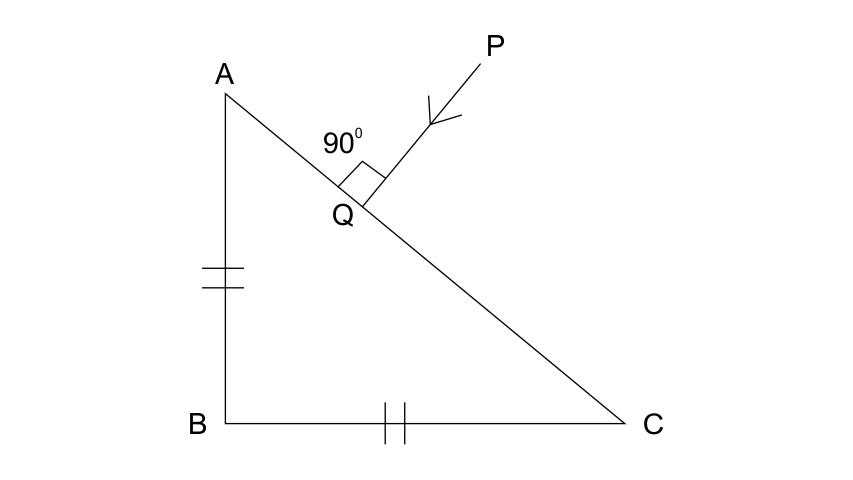
(a) Complete the path of the ray PQ until it emerges from the prism. Mark in the diagram the angle wherever necessary.
Ans:
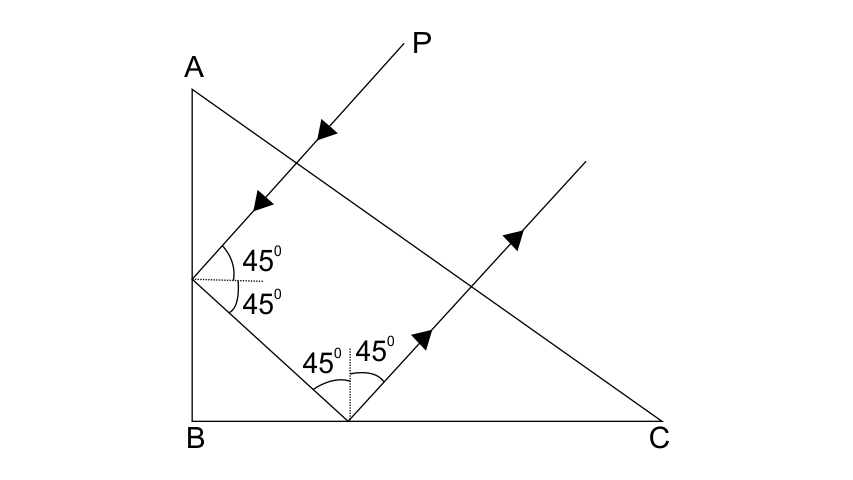
(b) What is the angle of deviation of the ray PQ?
Ans: Angle of deviation is 180o
(c) Name a device in which this action is used.
Ans: Prism binocular.
23. In Fig., a ray of light PQ is incident normally on the face AB of an equilateral glass prism. Complete the ray diagram showing its emergence into air after passing through the prism. Take critical angle for glass = 42°
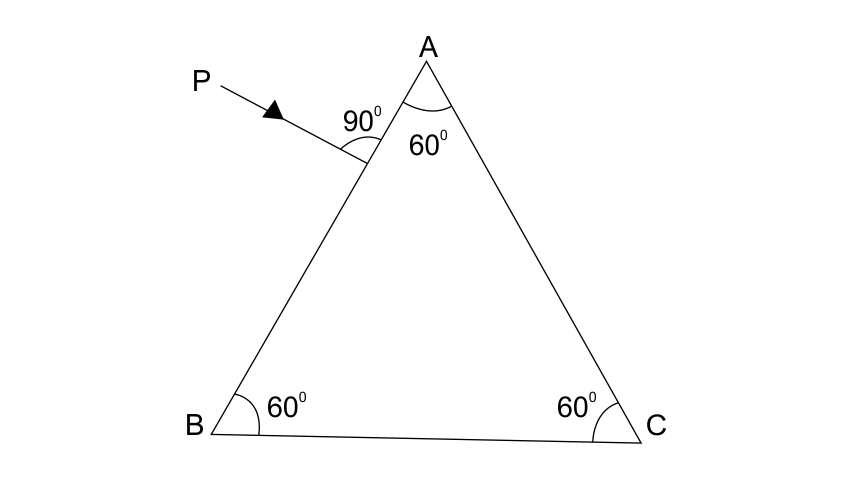
(a) Write the angles of incidence at the faces AB and AC of the prism.
Ans:
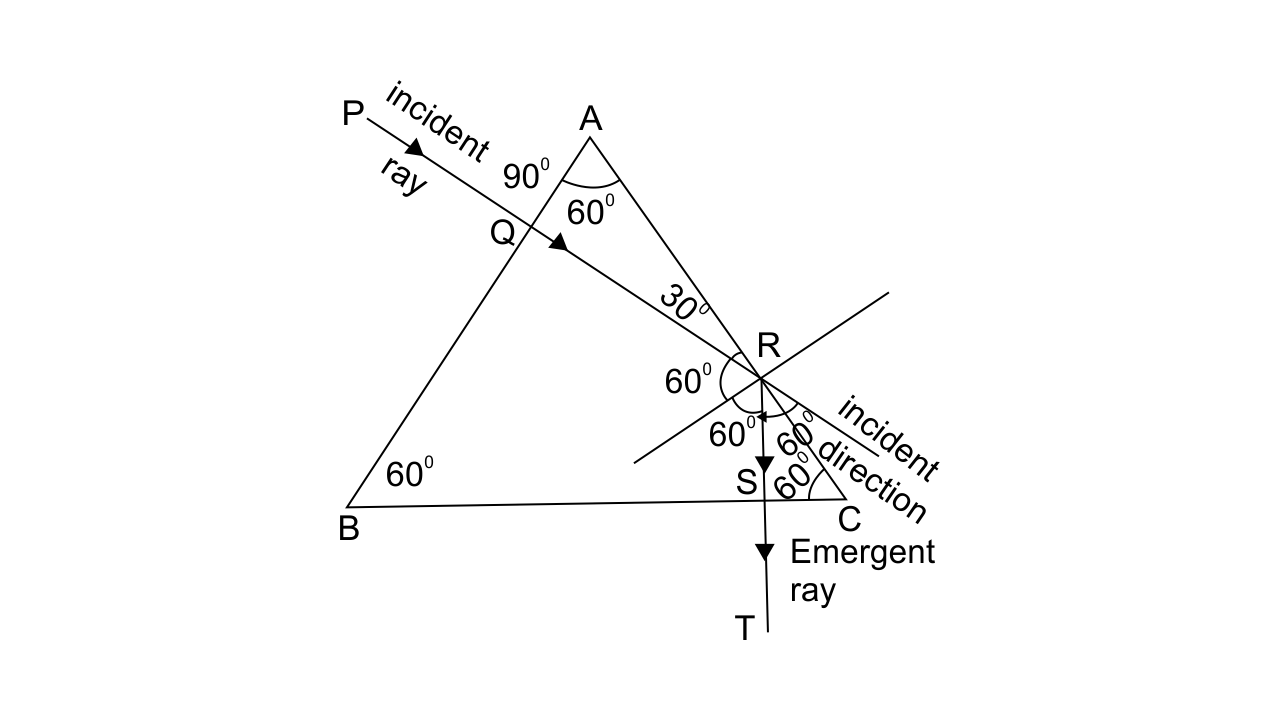
(a) At face AB, i=0oand at the face AC, i=60o.
(b) Name the phenomenon in which the ray of light suffers at the face AB, AC and BC of the prism.
Ans: At face AB – refraction,
At face AB – total internal reflection,
At face BC – refraction.
24. Copy the diagram given below and complete the path of the light ray till it emerges out of the prism. The critical angle of glass is 42o. In your diagram mark the angles wherever necessary.
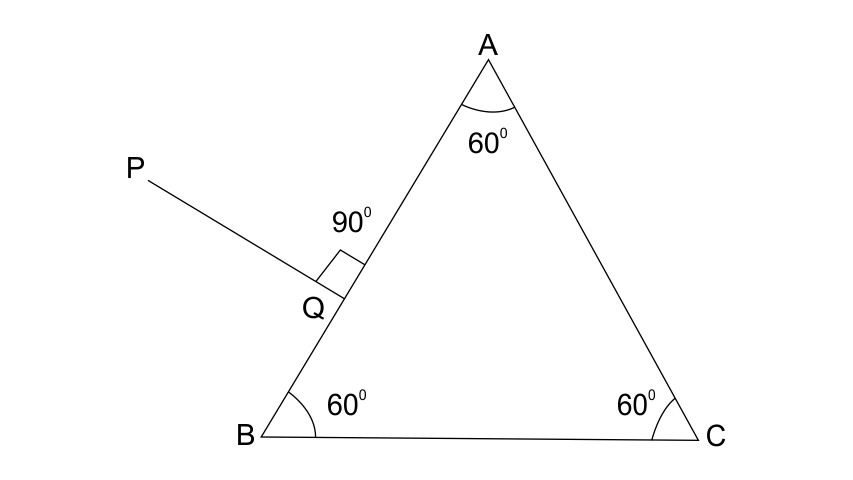
Ans: Angle of incident (on the boundary BC) is 60° which is more than its critical angle (42°). So, this incident light ray (QR) will not enter into the next medium, instead it undergoes total internal reflection. When this reflected ray (RS) reaches the side AC and its angle of incidence is 0° then again, it will not suffer any refraction, due to this angle of emergence will be 0°.
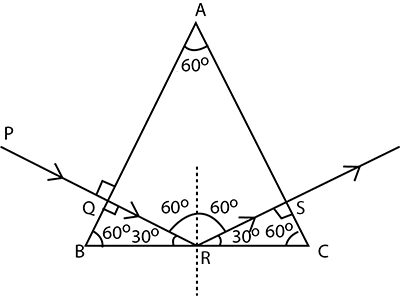
25. Draw a neat, labelled ray diagram to show the total internal reflection of a ray of light normally incident on one face of a 30°, 90°,60° prism.
Ans:
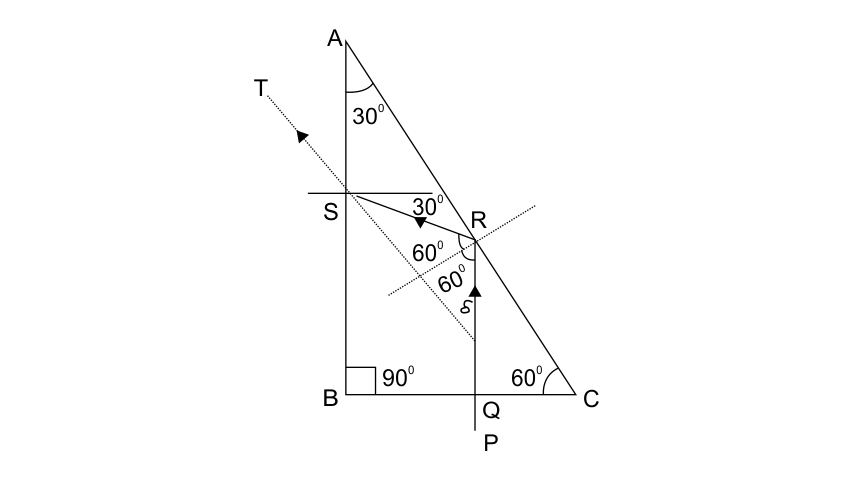
26. What device other than a plane mirror, can be used to turn a ray of light 180°? Draw a diagram in support of your answer. Name an instrument in which in which this device is used.
Ans: A total reflecting prism can be used to rotate a ray of light by 180°.
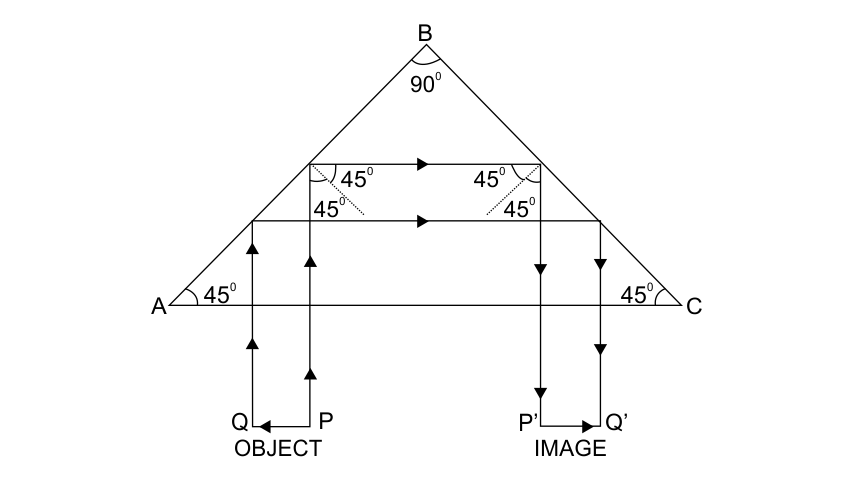
This action of prism is used in binoculars.
27. Mention one difference between reflection of light from a plane mirror and total internal reflection of light from a prism.
Ans: When total internal reflection occurs from a prism, the entire incident ray of light (100%) will be reflected back into the denser medium. While in ordinary reflection from a plane mirror, some of the ray of light will be refracted and absorbed so the reflection will be partial.
28. State one advantage of using a total reflecting prism as a reflector in place of a plane mirror.
Ans: A total reflecting prism gives an image more brighter than that obtained by using a plane mirror.
29. Two isosceles right – angled glass prisms are placed near each other as shown in Fig. Complete the path of the light ray entering the first prism till it emerges out of the second prism.
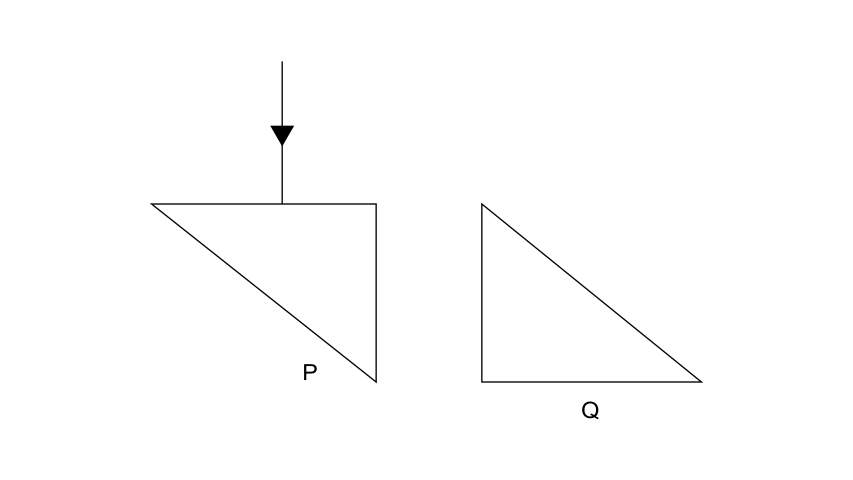
Ans:
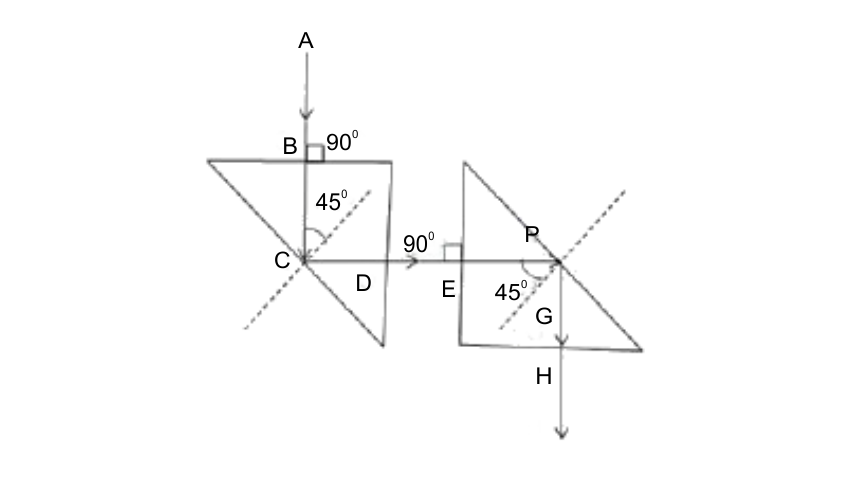
30. Complete the path of ray PQ through the glass prism ABC shown in figure till it emerges out of the prism. Given the critical angle of the glass is 42o.
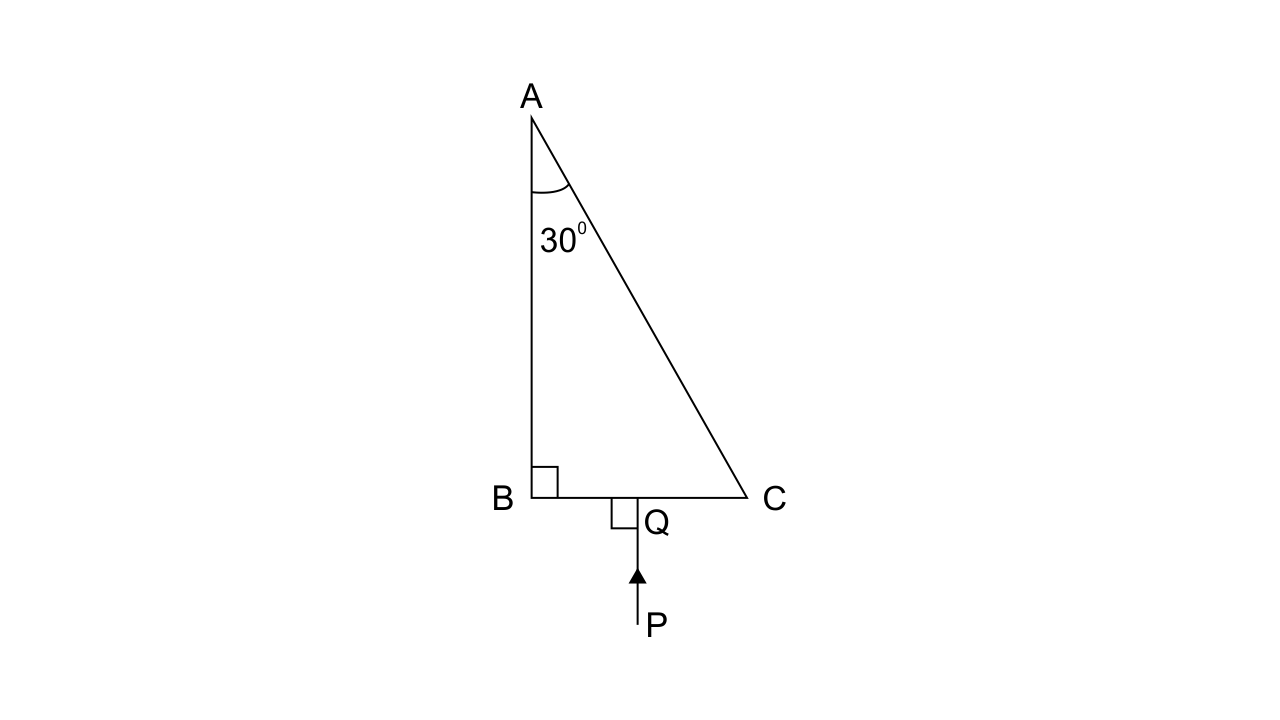
Ans:

Multiple Choice Type:
1. The critical angle for glass-air interface is :
(a) 24°
(b) 48°
(c) 42°
(d) 45°
Ans: The correct option is (c).
2. A total reflecting right angled isosceles prism can be used to deviate a ray of light through
(a) 30°
(b) 60°
(c) 75°
(d) 90°
Ans: The correct option is (d).
Hint:

3. A total reflecting equilateral prism can be used to deviate a ray of light through:
(a) 30°
(b) 60°
(c) 75°
(d) 90°
Ans: The correct option is (b).
Hint:

Solutions for Class 10 Physics Chapter 4
Solution for the Class 10 Physics ICSE Board chapter 4 Refraction of light at Plane Surfaces is available at Vedantu.
The physics textbook for Class 10 of the Indian Certificate of Secondary Education, commonly known as ICSE board, is published by Selina publishers. Chapter 4 of this book is Refraction of light at plane surface and the solution for the same is now available at Vedantu for free download.
This is the first chapter under section “B” “Light” of physics textbook for Class 10 ICSE board (Selina Publishers).
The chapter is divided into four parts in total, A, B, C, and D.
Part A is Called Refraction, Laws of Refraction and Refractive Index. This Part Discusses the Below Given 7 Topics:
Refraction of light.
Laws of Refraction.
Then comes, Speed of light in different media; Relationship between refractive index and speed of light.
Principle of Reversibility of the path of light.
Experimental verification of laws of refraction and determination of the refractive index of glass.
Then comes, Refraction of light through a rectangular glass block.
Multiple images in a thick plane Glass plate or Thick Mirror.
Part B is the Refraction of Light Through a Prism, and it Discusses Below Given Two Topics.
Prism.
Refraction of light through a prism.
Part C is a Simple Application of Refraction of Light. This Part Discusses Three Topics.
Real and apparent depth.
Apparent Bending of a stick underwater.
Lastly, comes, Some consequences of the refraction of light.
Part D is the Final Part Which is Called, “Critical Angle and Total Internal Reflection”. This Section Discusses a Total of 7 Topics.
The first topic is, Transmission of light from a Denser medium to a rarer medium at different angles of incidence.
Critical Angle.
Then comes, Relationship between the critical angle and the refractive index.
Total internal reflection.
Total internal reflection in a prism.
Use of a total internal reflecting prism in a place of a plane mirror.
Some consequences of total internal reflection.
As the chapter is divided into two parts (A and B) The exercise for chapter 4 of the physics textbook for Class 10 ICSE board is divided into two parts as well.
The first exercise, that is to say, is Exercise 4 (A). Comes right after the first part of the chapter Refraction, laws of Refraction and Refractive Index completes.
The exercise consists of 31 questions in total, the last four of which are multiple-choice questions.
The second exercise which is exercise 4 (B) has 19 questions in total with one Multiple choice question.
The exercise for the third section, “Exercise 4 (C)”, has a total of 12 questions with two multiple-choice questions at the end.
And for the last section which is “Exercise 4 (d)” students are required to answer 31 questions with 4 multiple choices towards the end.
These many questions may seem a little intimidating, but Vedantu makes it easy for the students. At Vedantu, students can find detailed solutions for each of the questions available for download and it is also totally free.
FAQs on Chapter- 4 Refraction of Light at Plane Surfaces (ICSE board) (Selina Publishers) Content.
1. What is Refraction?
In simple language, we can say that refraction is the phenomenon that occurs when the light passes from one transparent medium to another transparent medium and changes the direction of its path. But of course the Class 10 Physics ICSE Board chapter 4 Refraction of light at Plane Surfaces has much more to offer, you will learn about everything in the chapter. You will learn the chapter even better once you start solving the questions asked in the exercise section.
2. I have learned and understood everything in Chapter 4 “Refraction, laws of Refraction and Refractive Index”. Can I skip the exercise?
Skipping the exercise is not an option. Because no matter how well you have understood all the concepts, a student always has to go through a series of tests. Therefore, consider the exercise as the test of your understanding. Just like we do physical exercise for physical fitness, we have intellectual exercise for intellectual fitness. to solve the exercise you will have to read the part of the chapter over and over again, in that manner your mind will remember the whole chapter at the end.
3. I have completed the exercise; how can I make sure that my solution is right?
It's very simple. All you have to do is to visit Vedantu and find the Solutions for Class 10 physics ICSE Board chapter 4 Refraction, laws of Refraction and Refractive Index, and compare your solution with the solutions of the expert teachers. The solution provided by the teachers of the Vedantu, is prepared in a step by step manner, so there will not be any trouble for you to check your answers for the same. Also, checking the answers will help you clear your concepts even more.
4. Why should one refer only to Vedantu?
Because at Vedantu you will find the solutions prepared for you by the team of expert educators, who have a passion for learning and teaching. Everything is explained clearly. You can find Step by step solutions for all the questions. With the solution of the exercise, you will also find the explanation of the same, which follows the guidelines of the ICSE board. Therefore, Vedantu will help you understand the concepts very easily at a deeper and a better level.
5. Does Vedantu provide the explanation of the multiple choice questions?
Yes, as said earlier, in the Vedantu Solution for the Class 10 Physics ICSE Board Chapter 4 Refraction of light at Plane Surfaces, our expert teachers explain everything, including multiple-choice questions. Our teachers know very well that providing solutions will not at all be helpful for the students, because if the student has not understood the concept, it will not do any good to the student. Hence, explanation is must for any solution, whether it is a detailed question or a multiple choice type question.








































